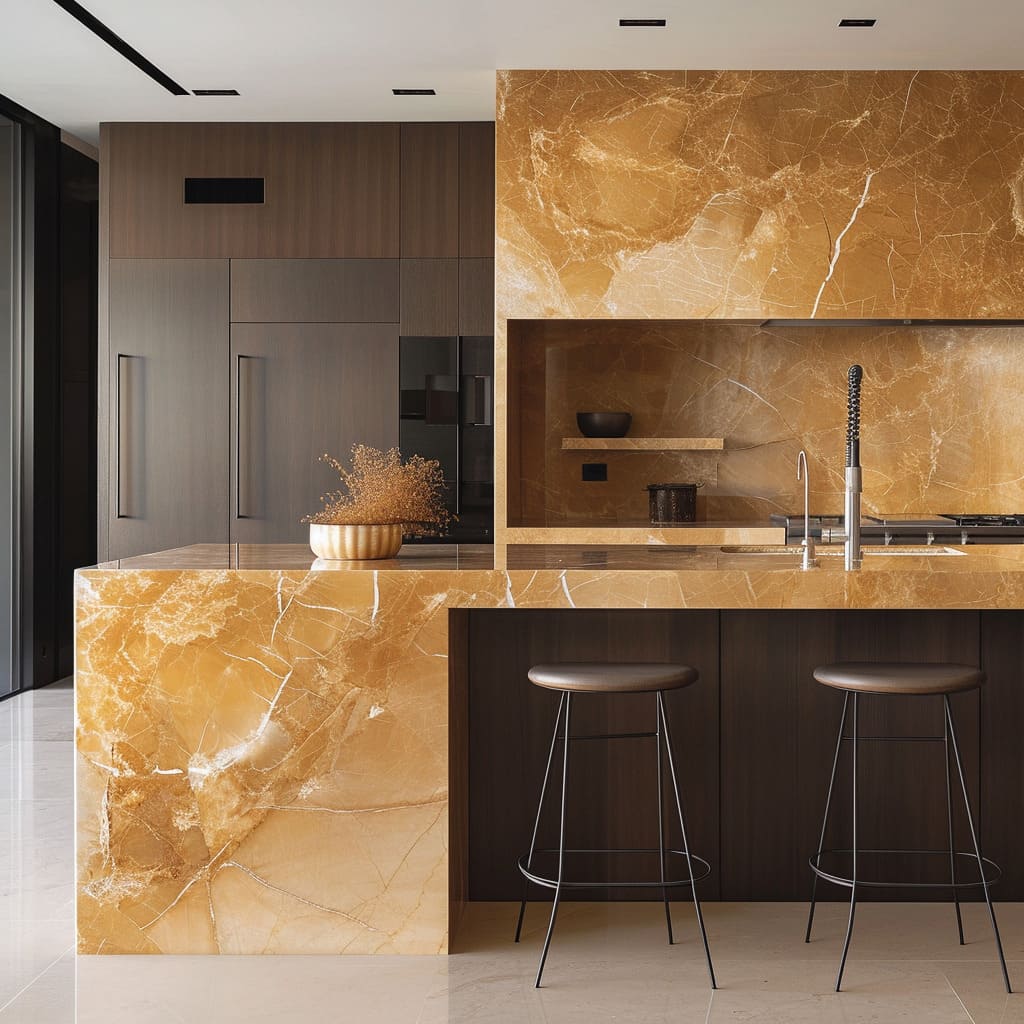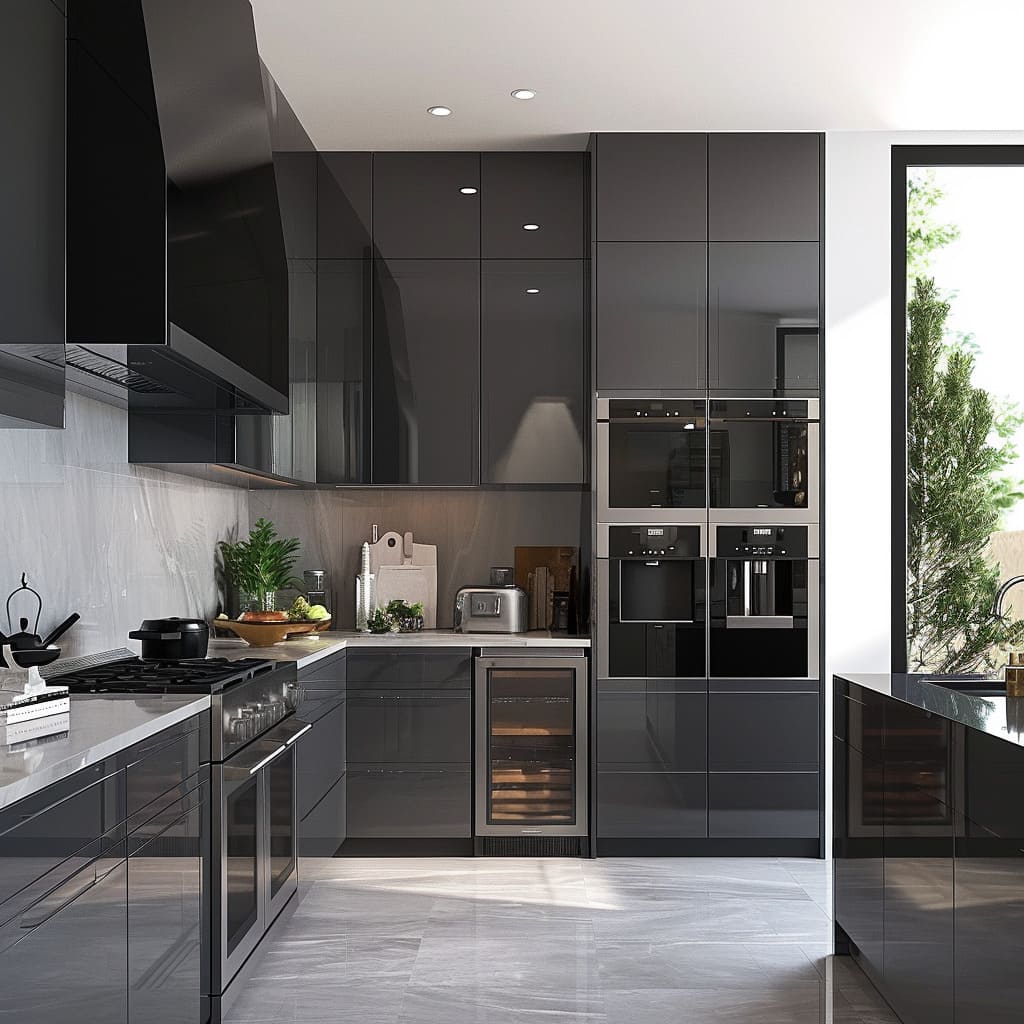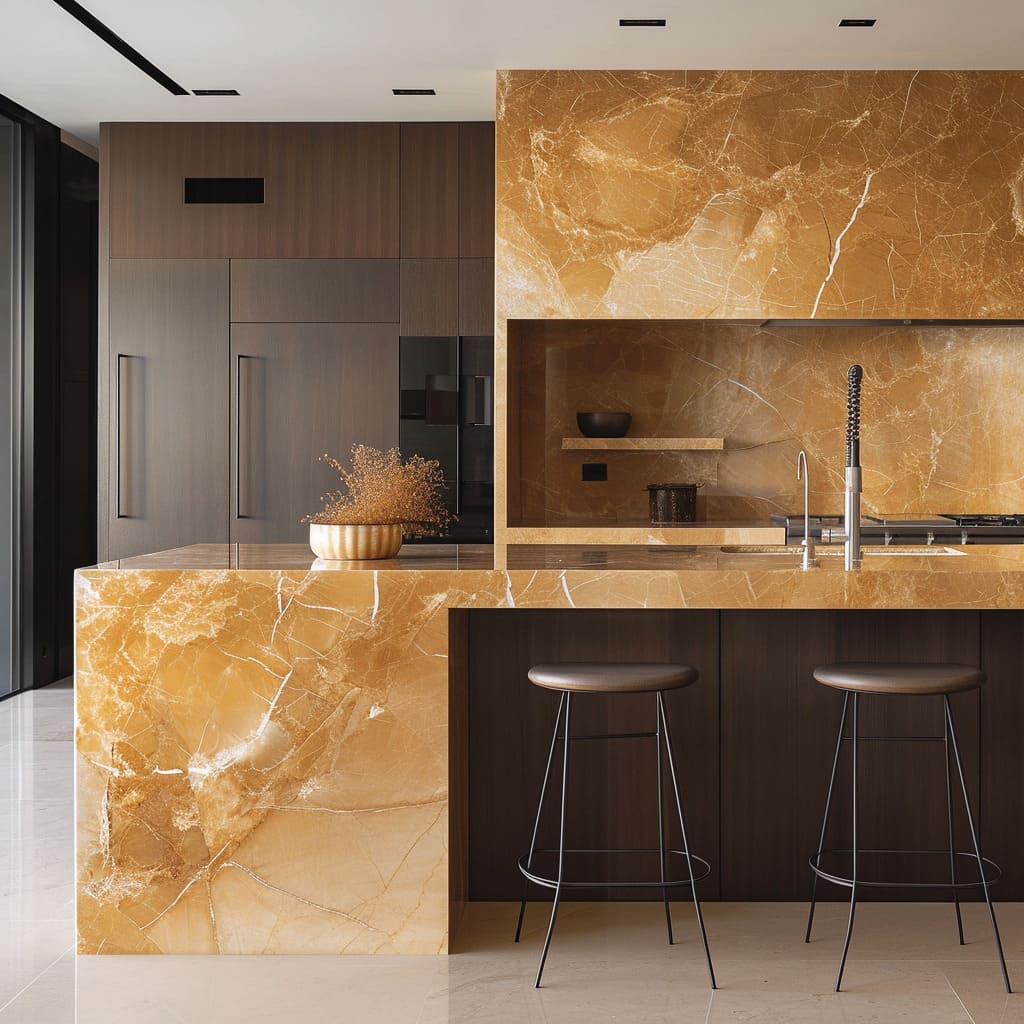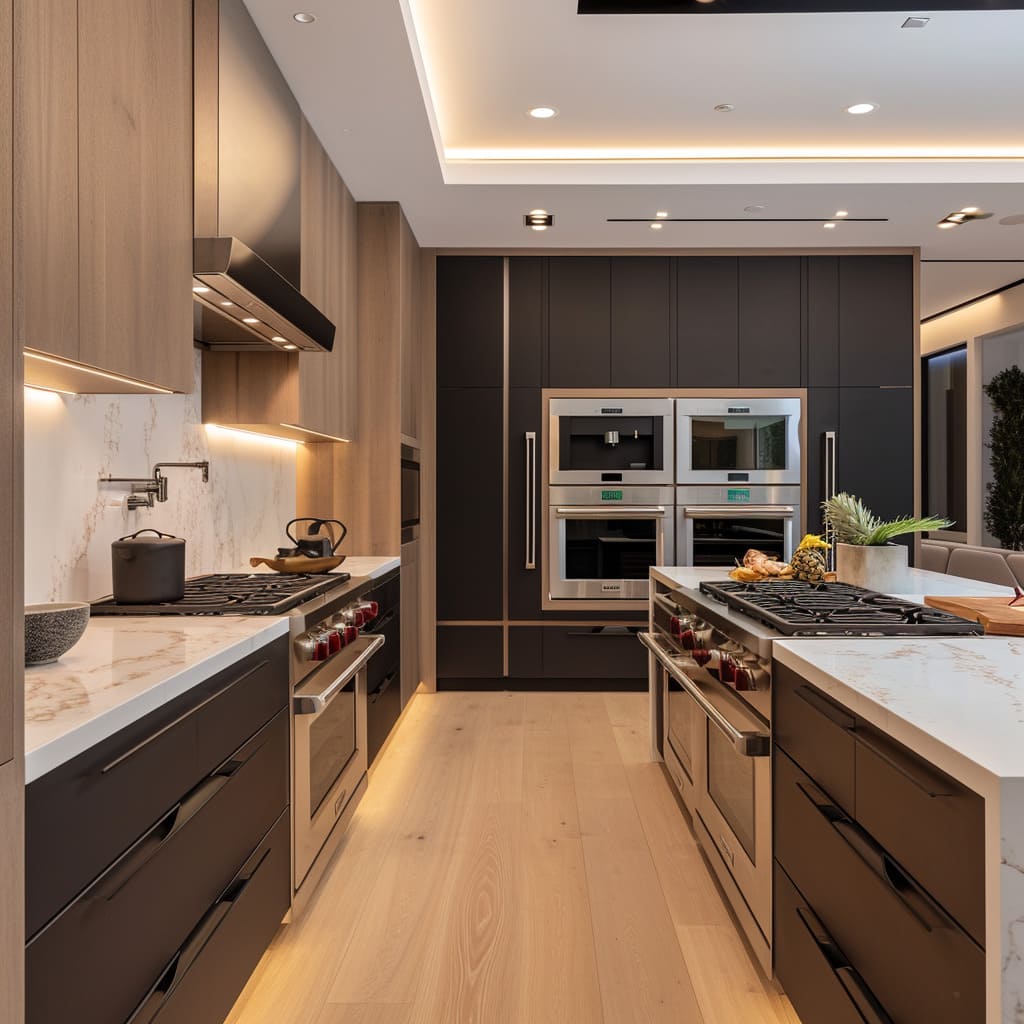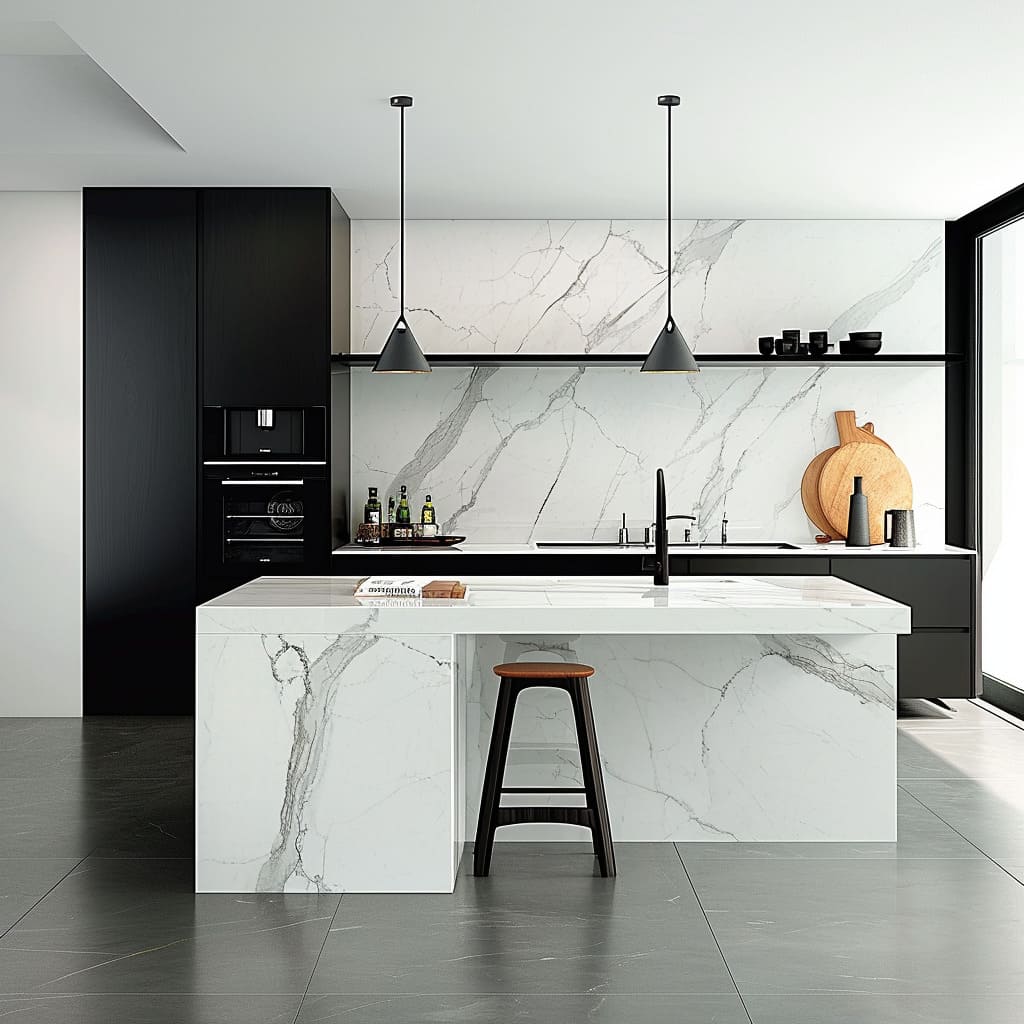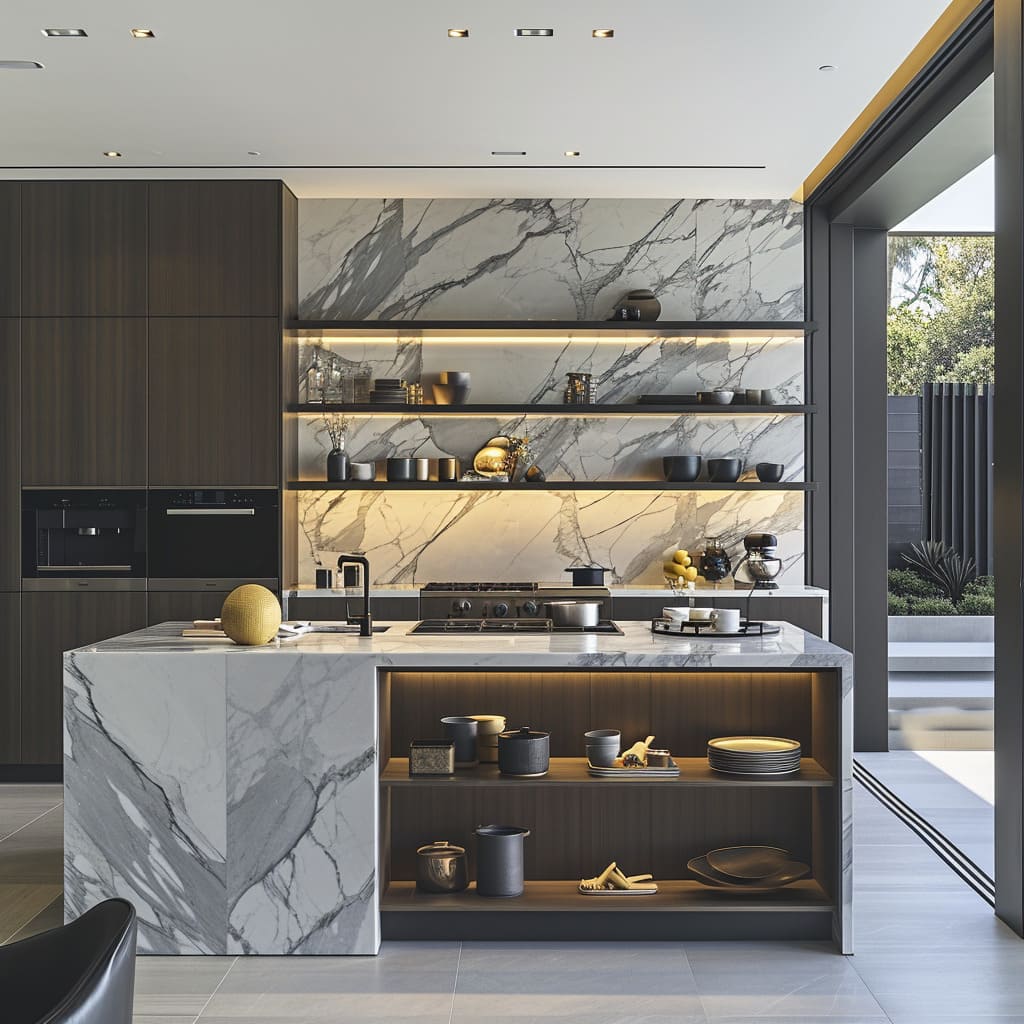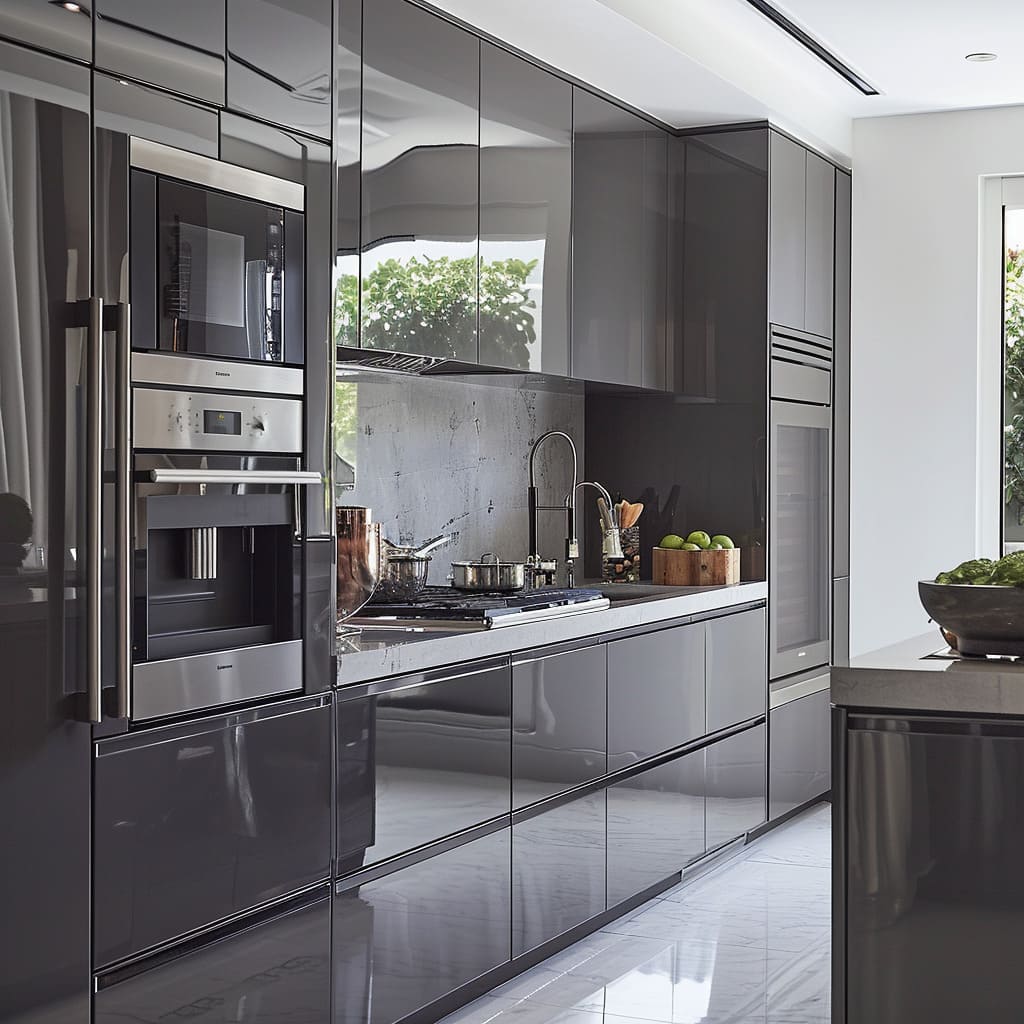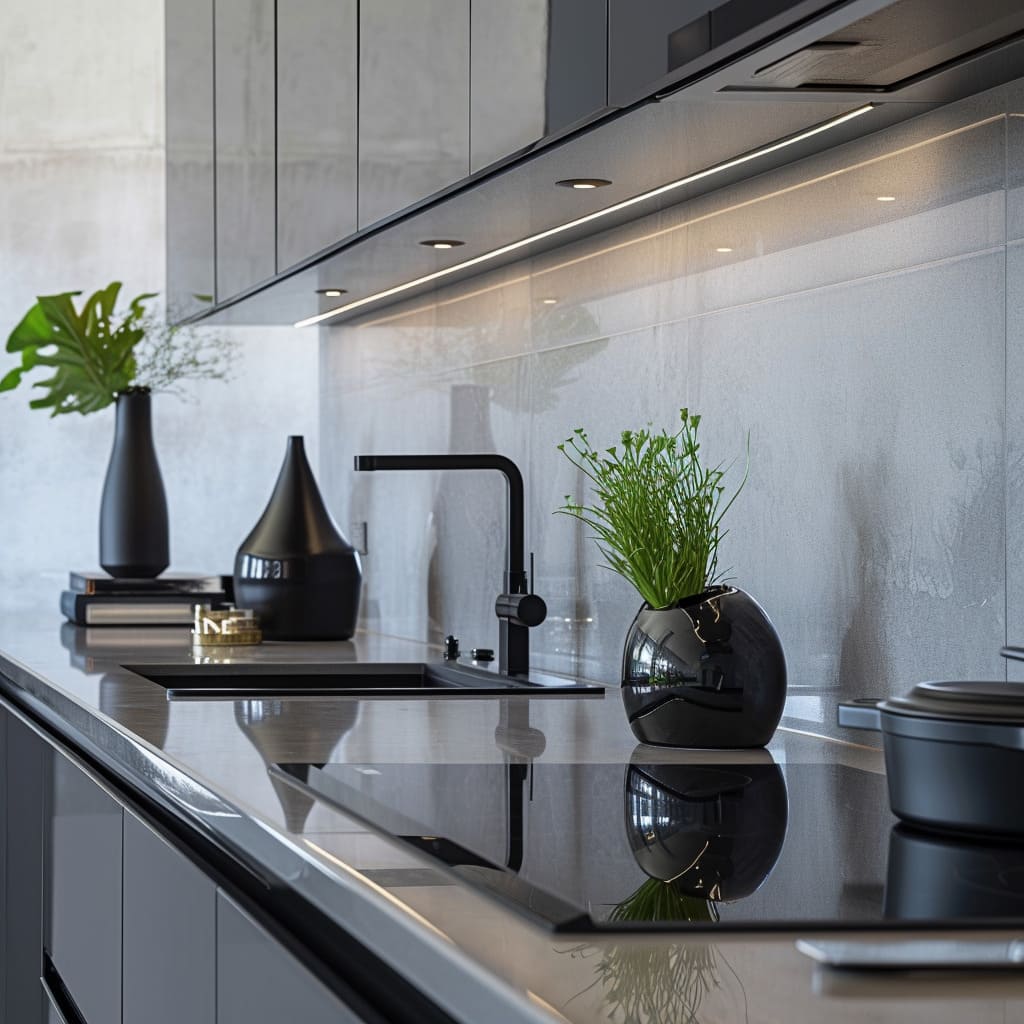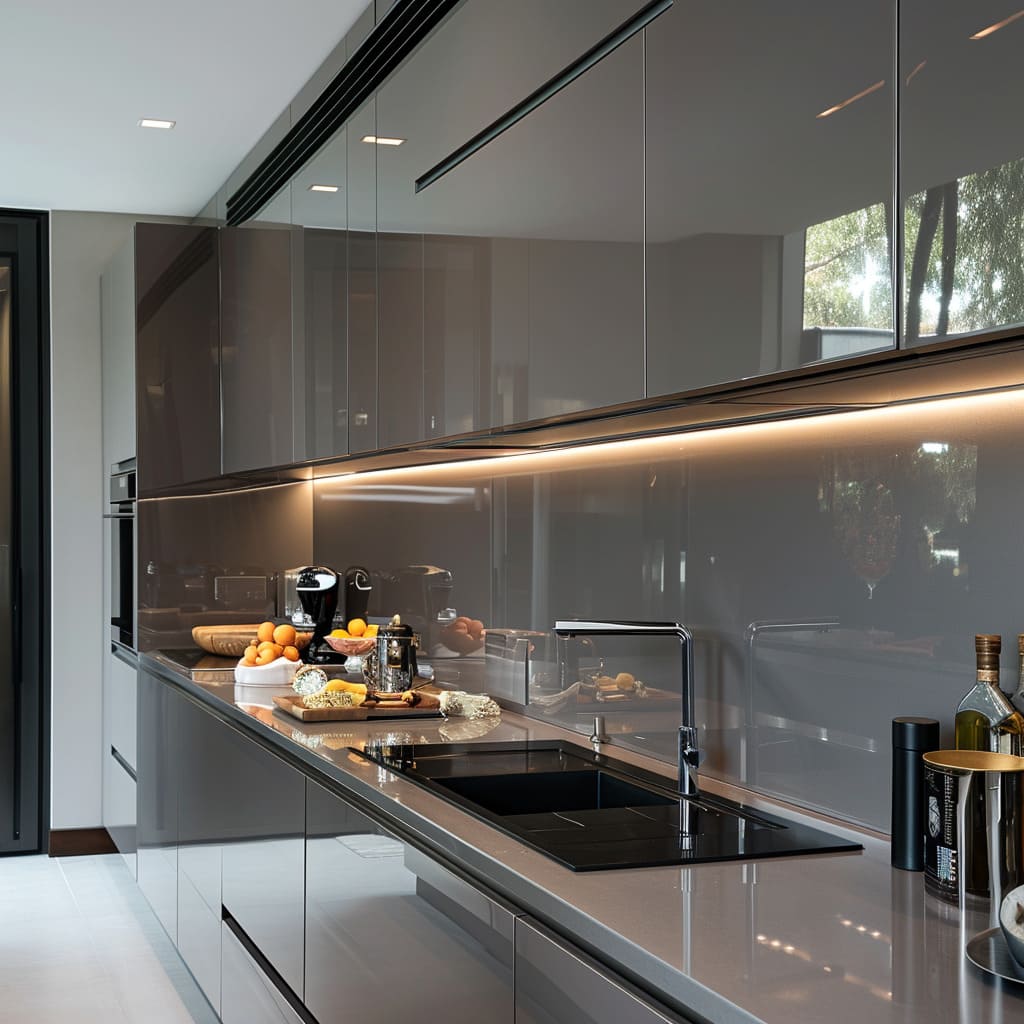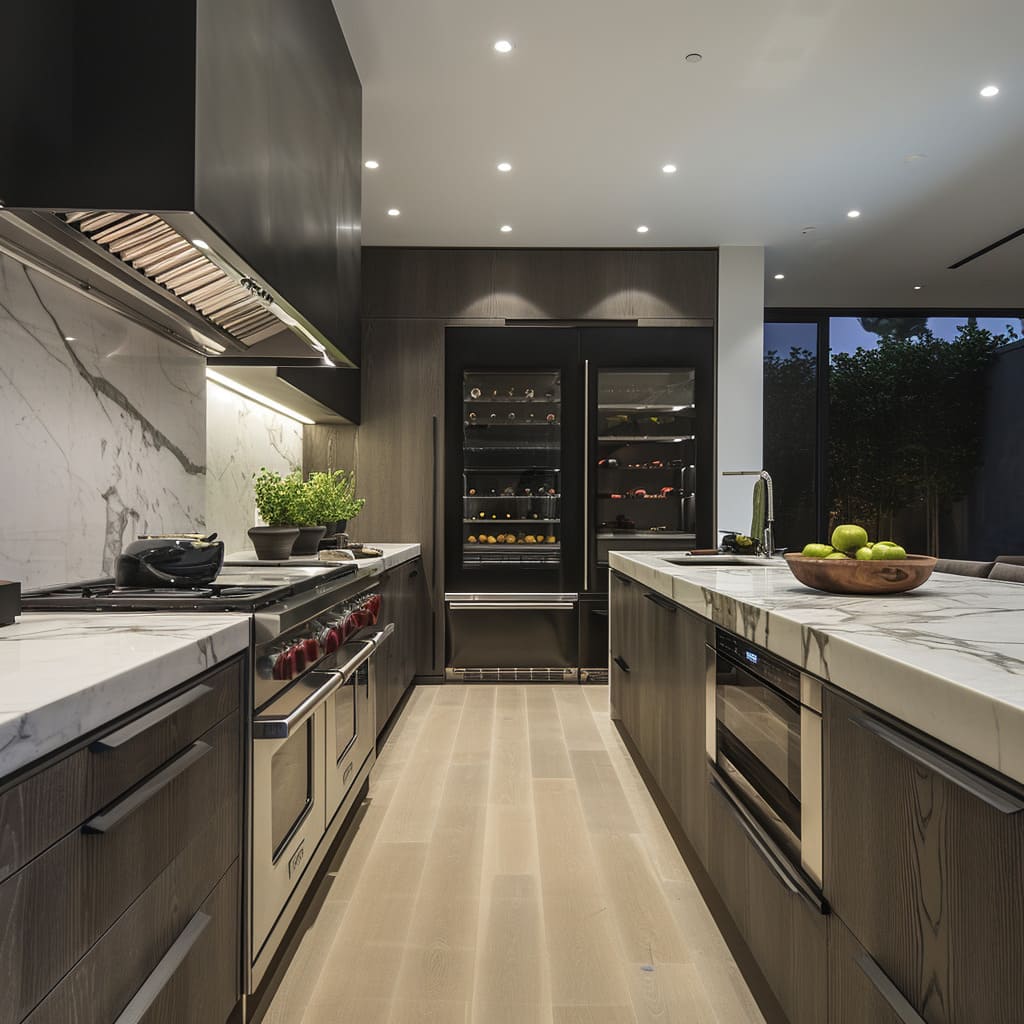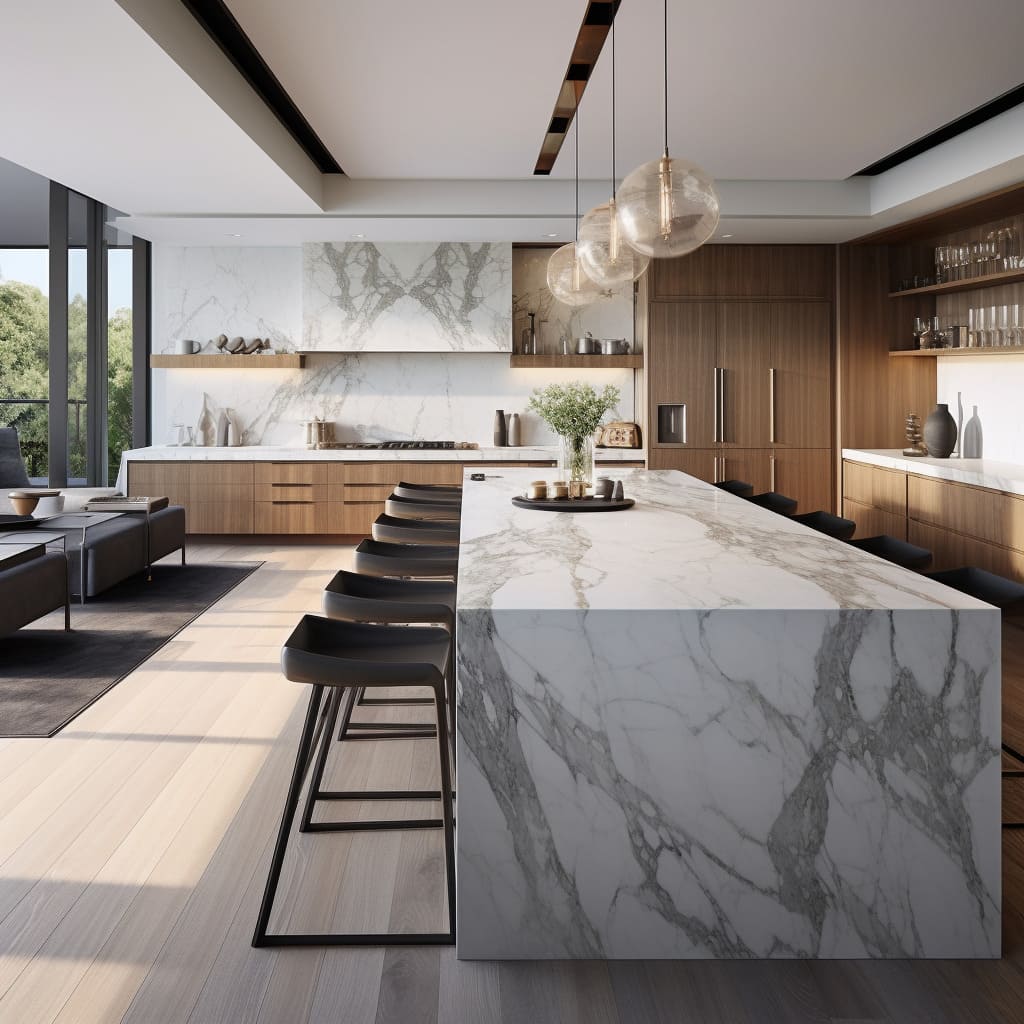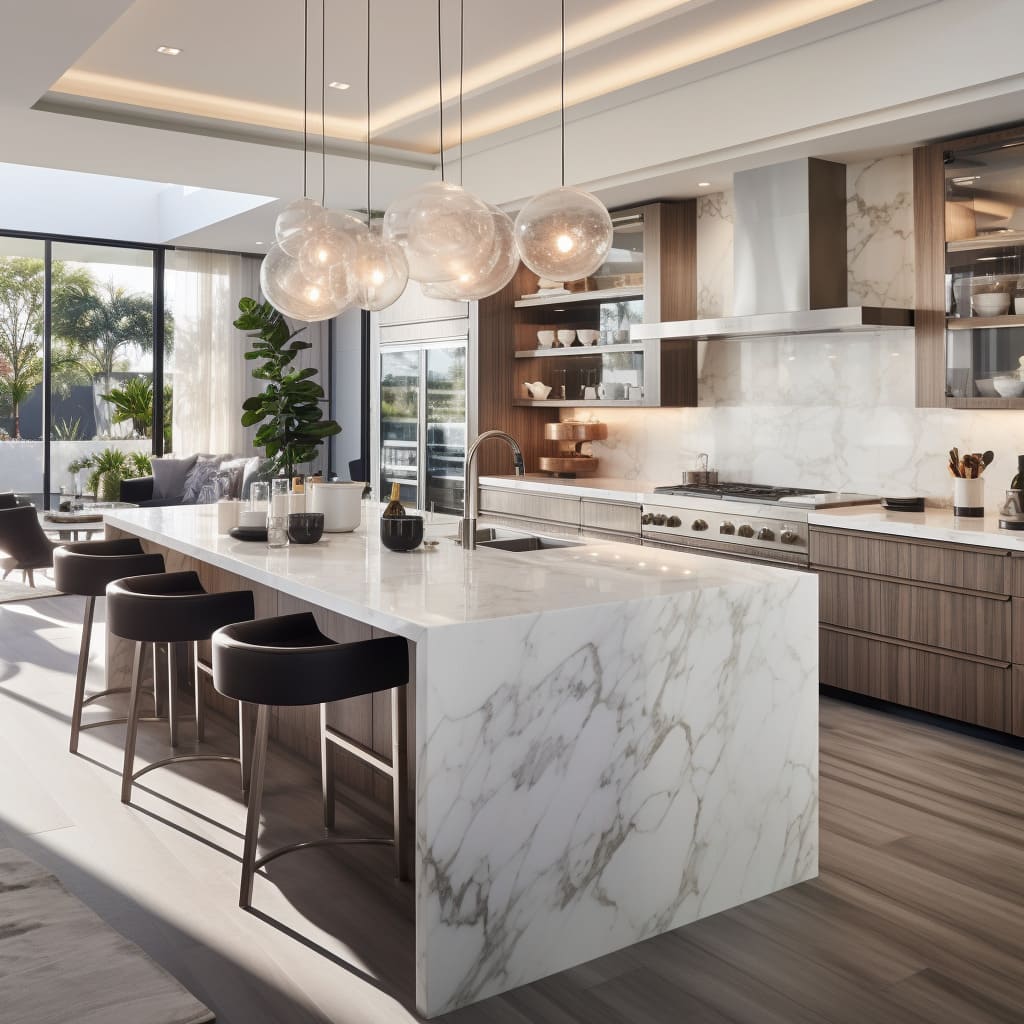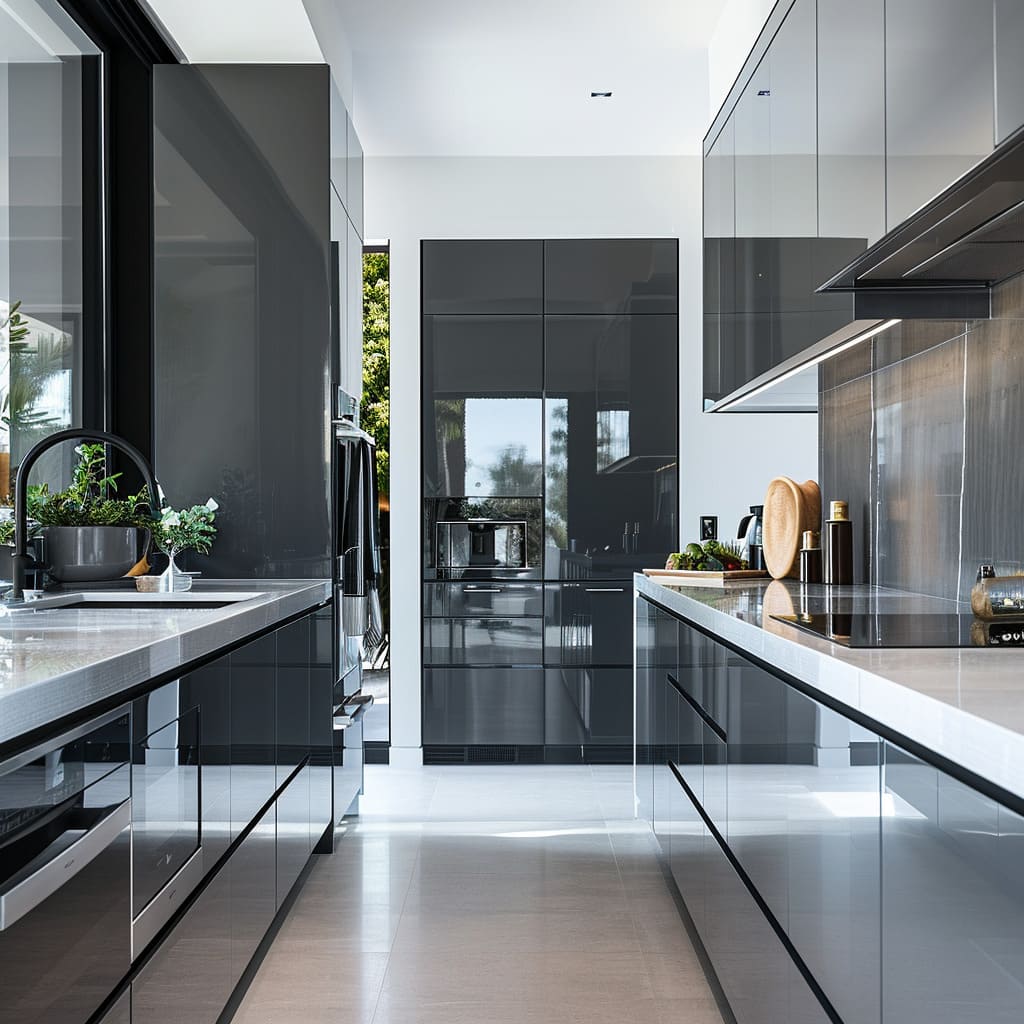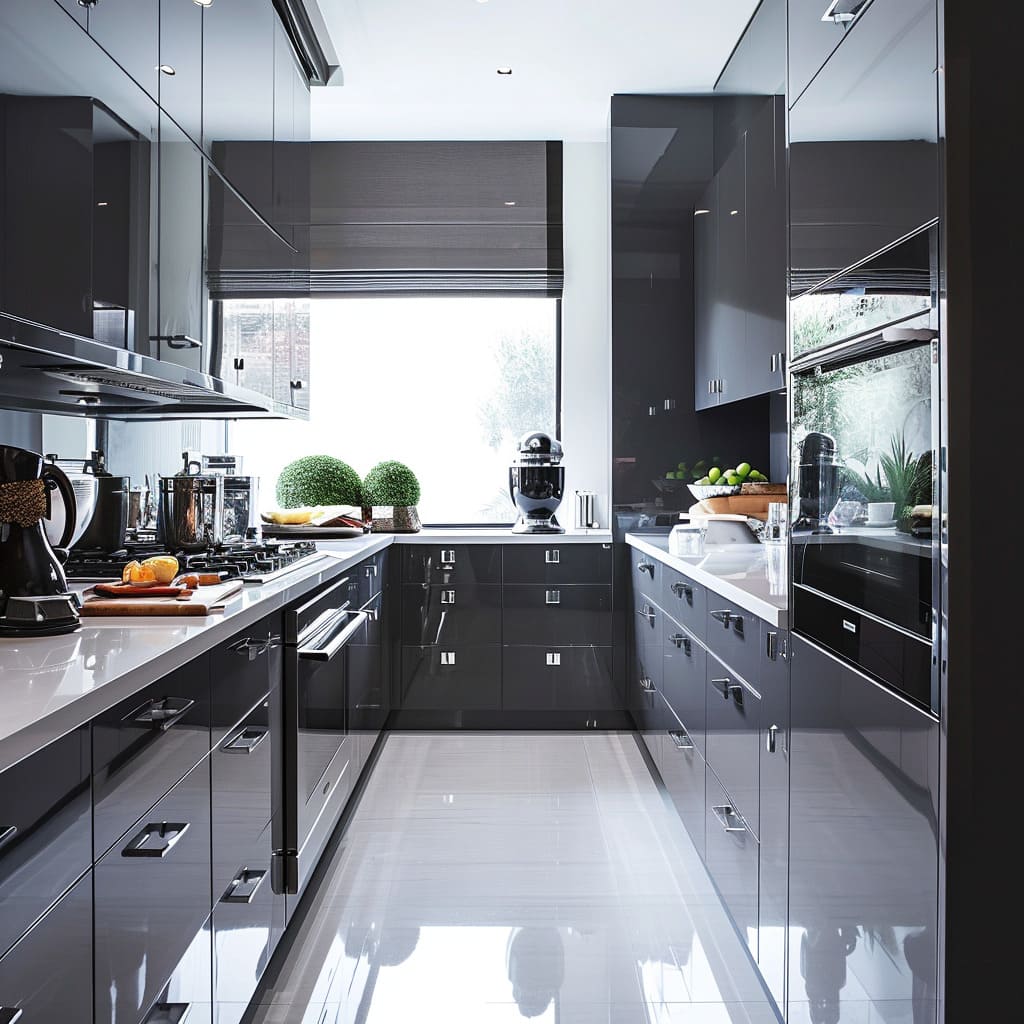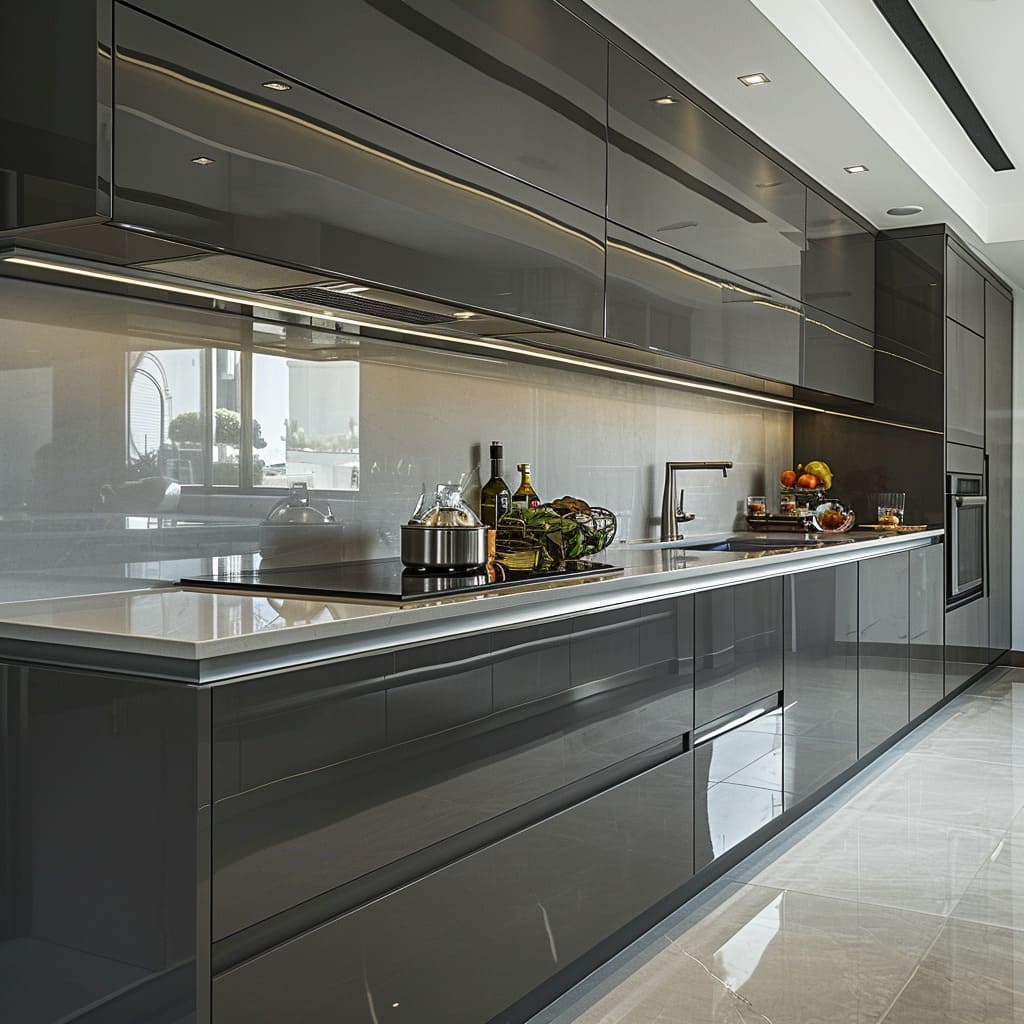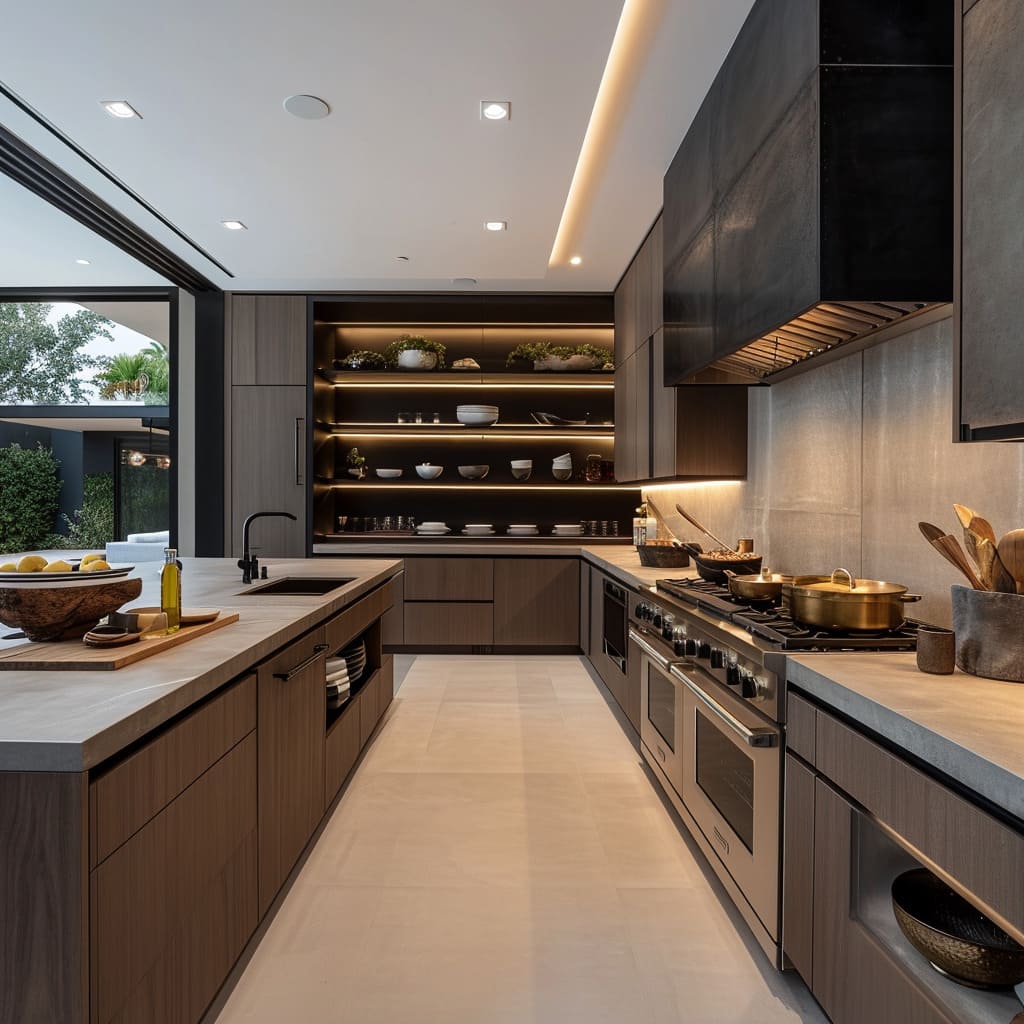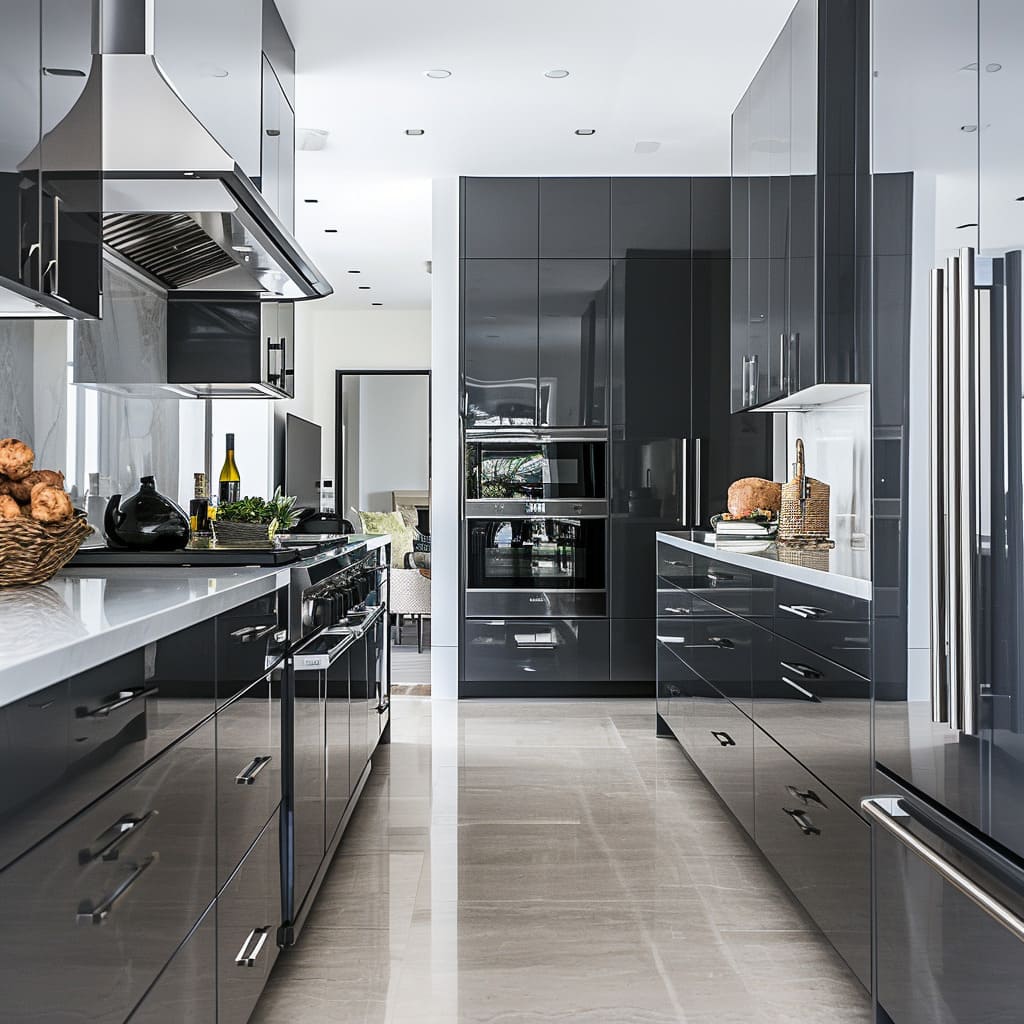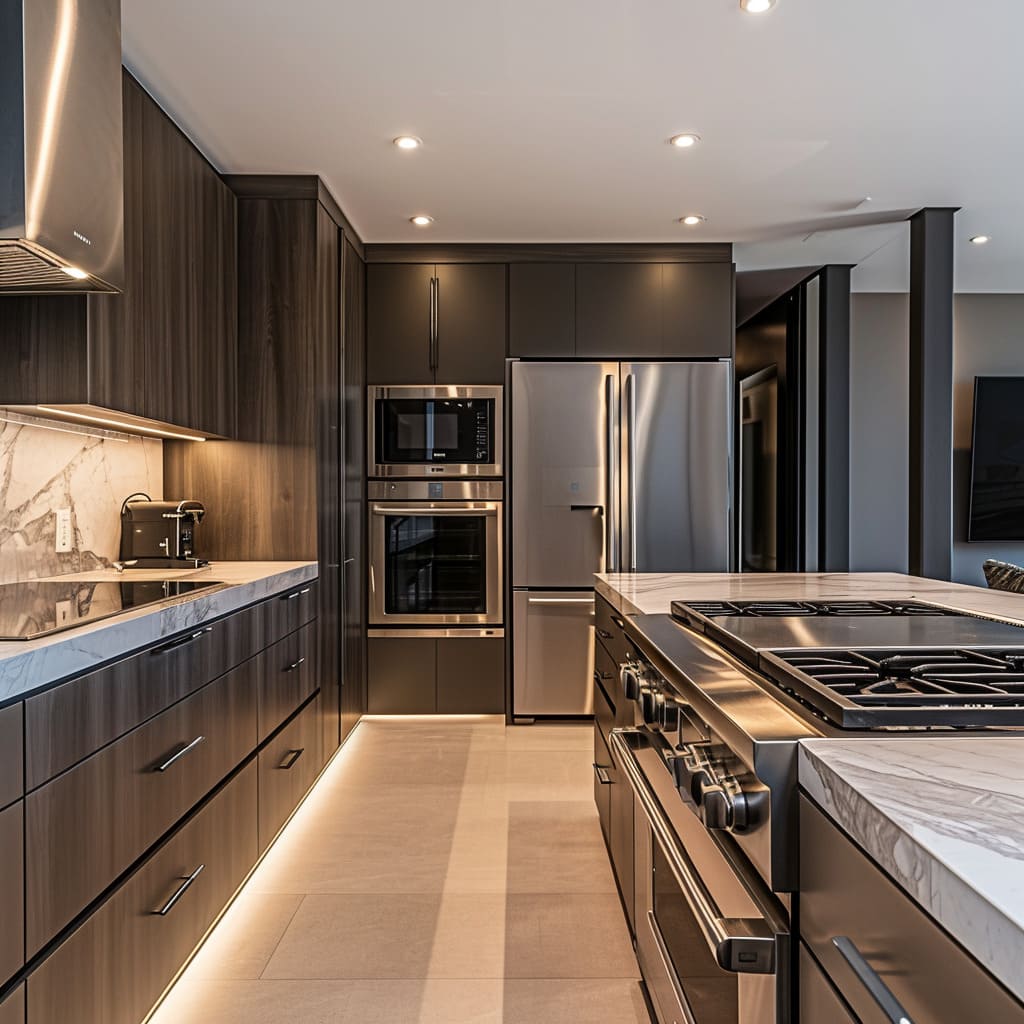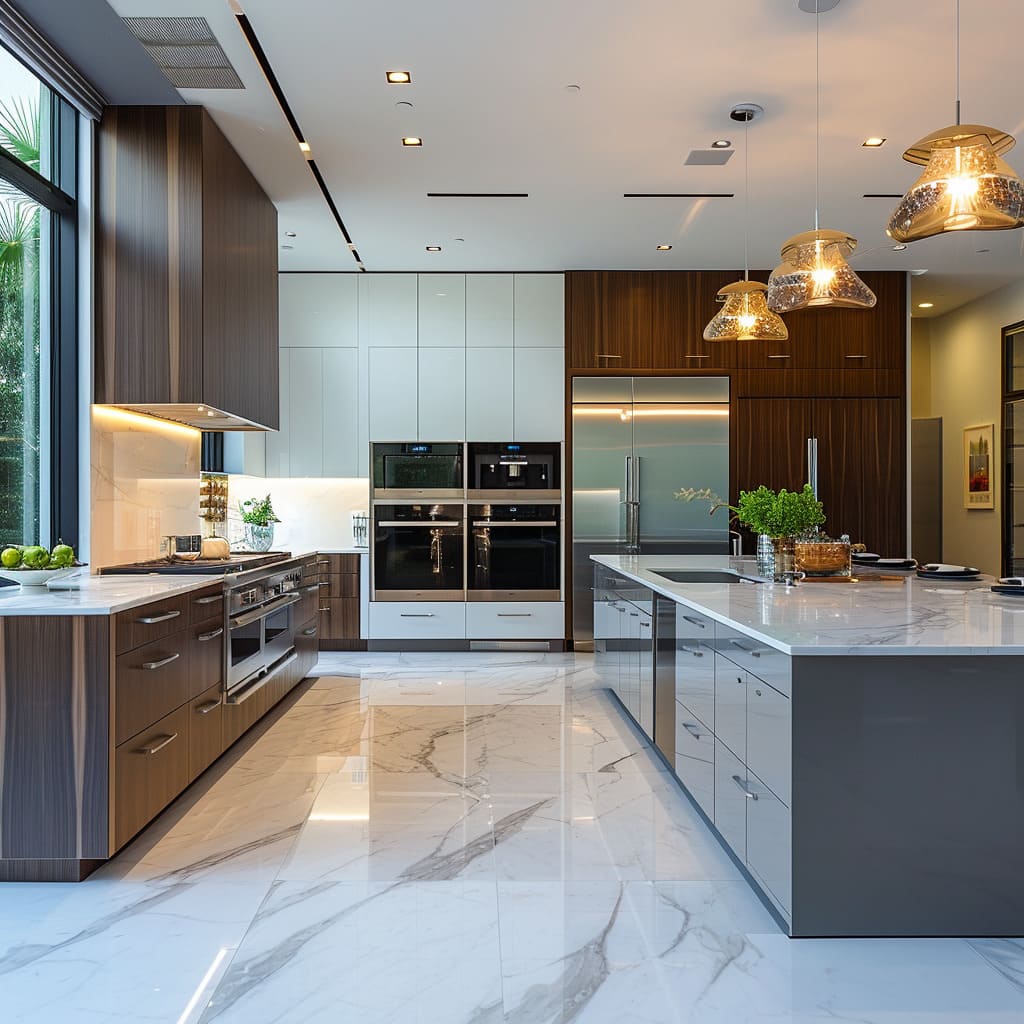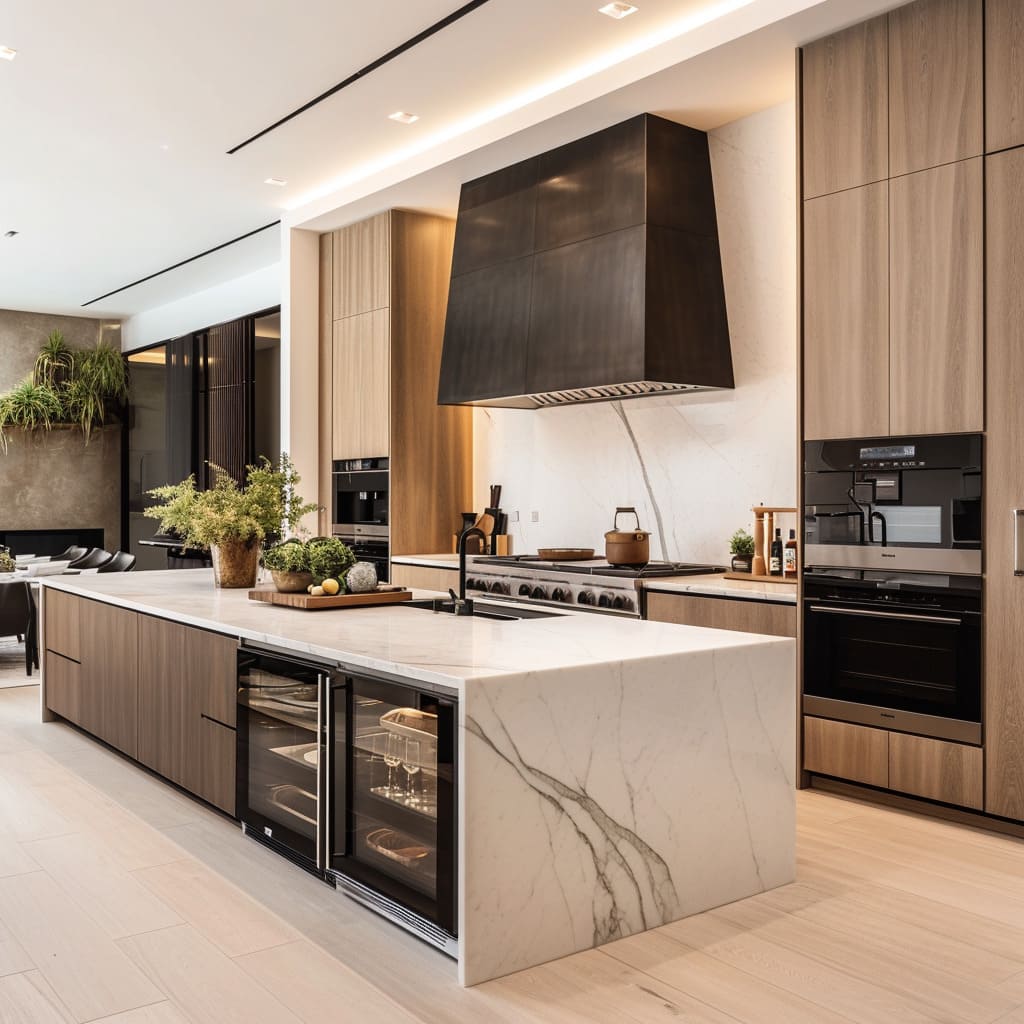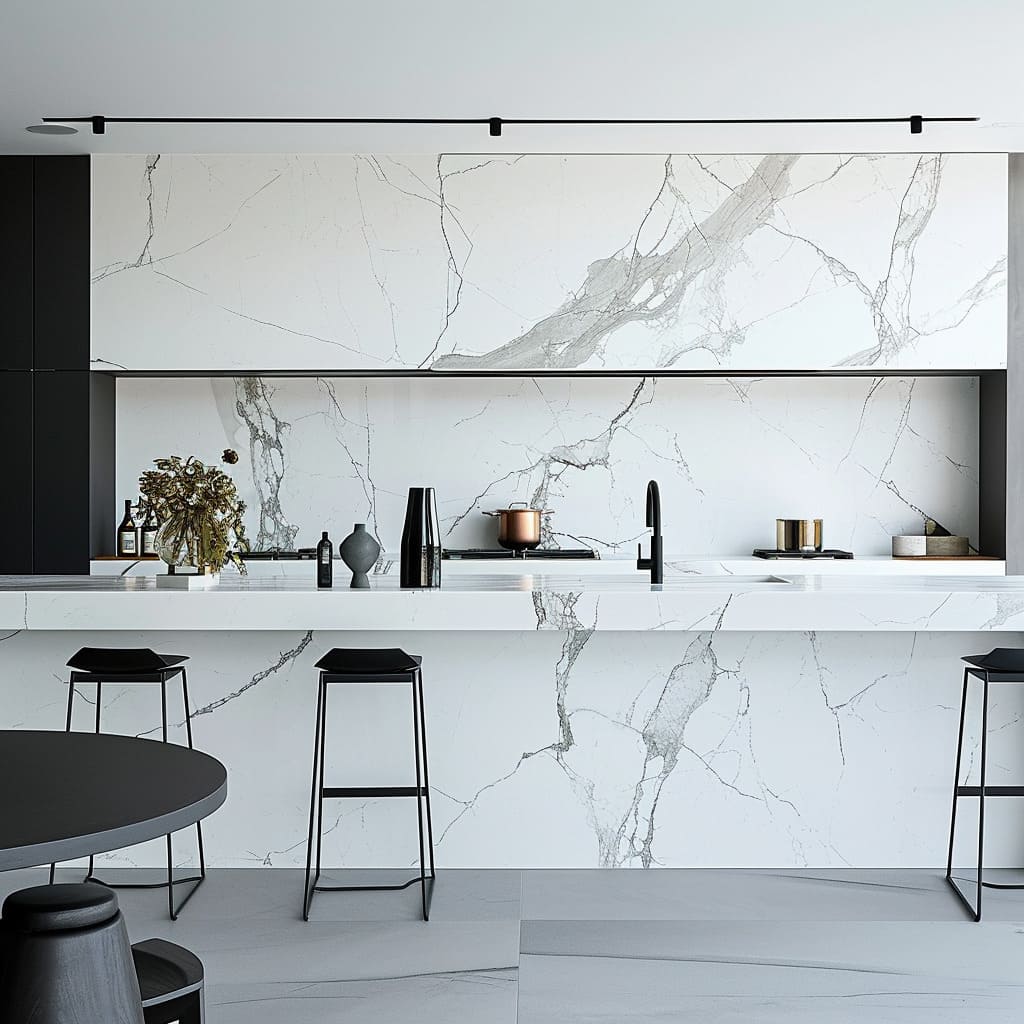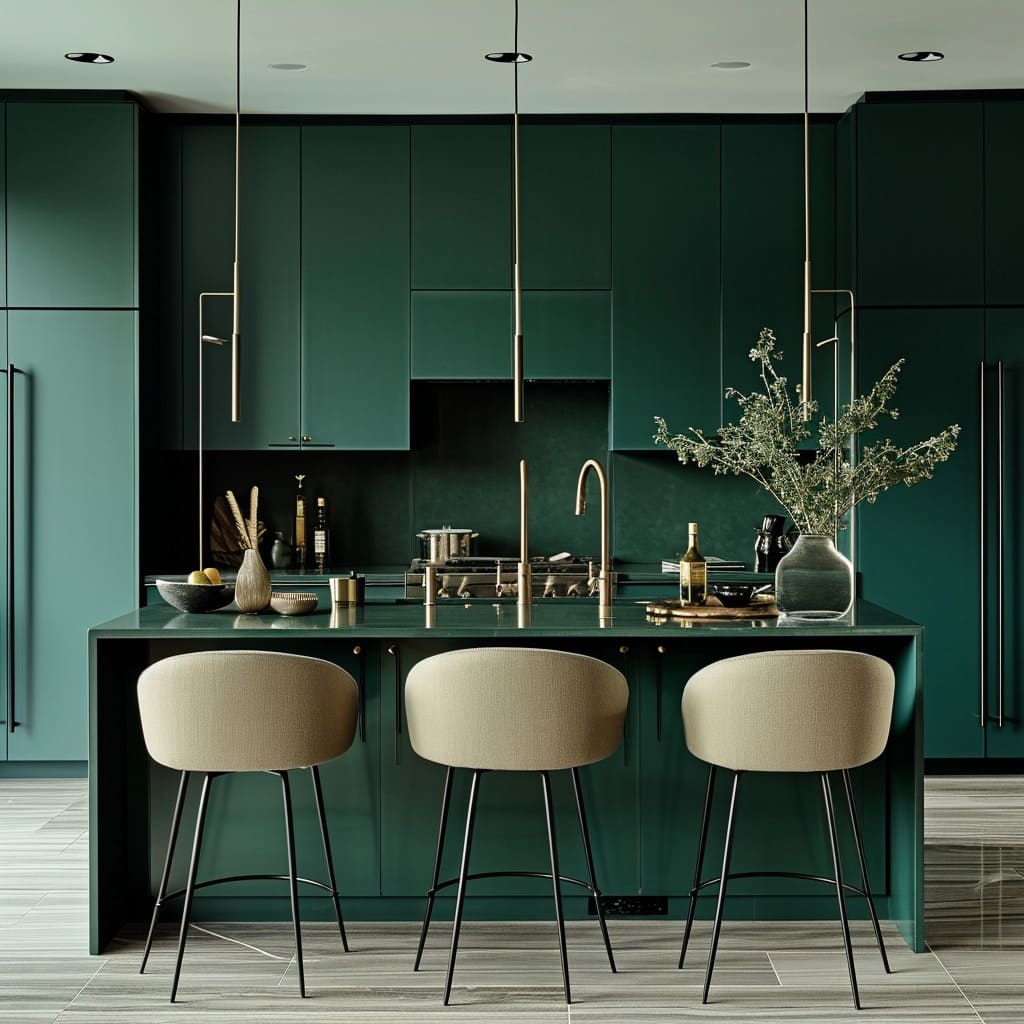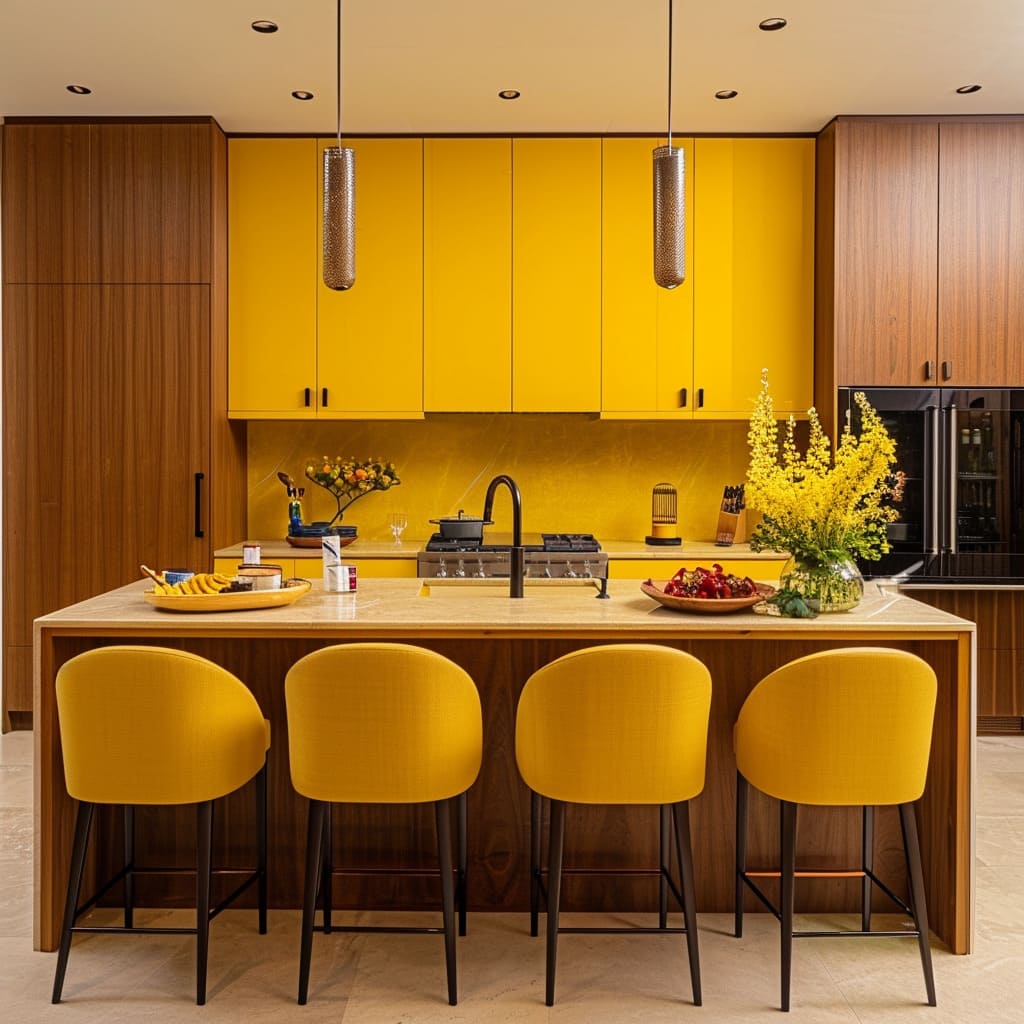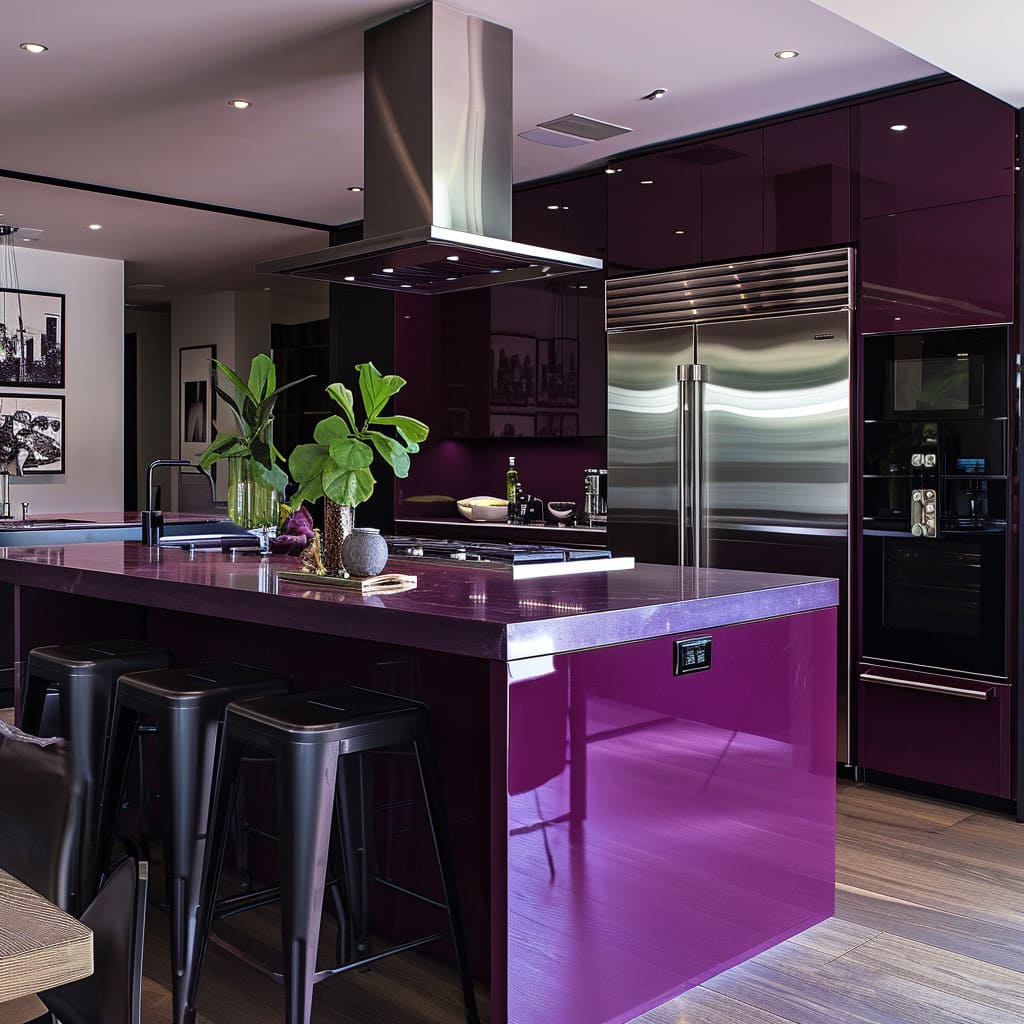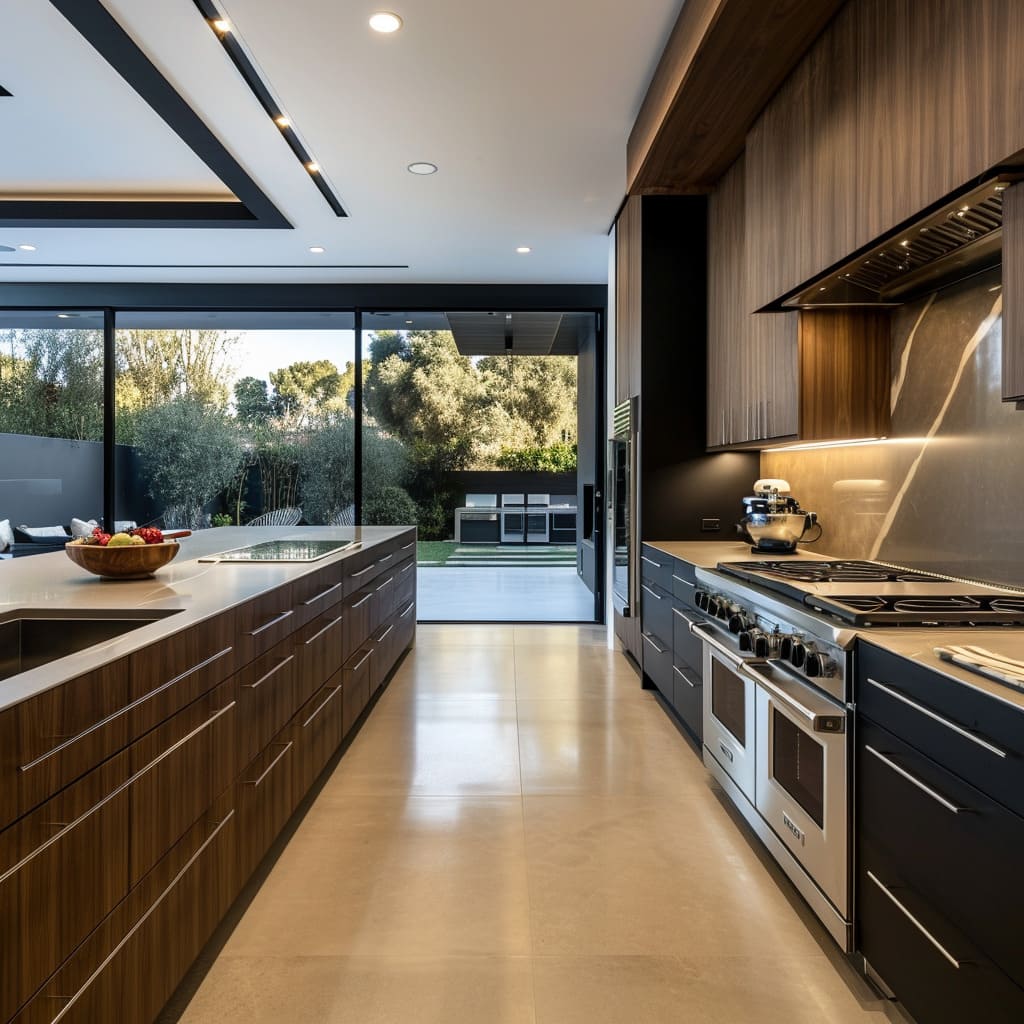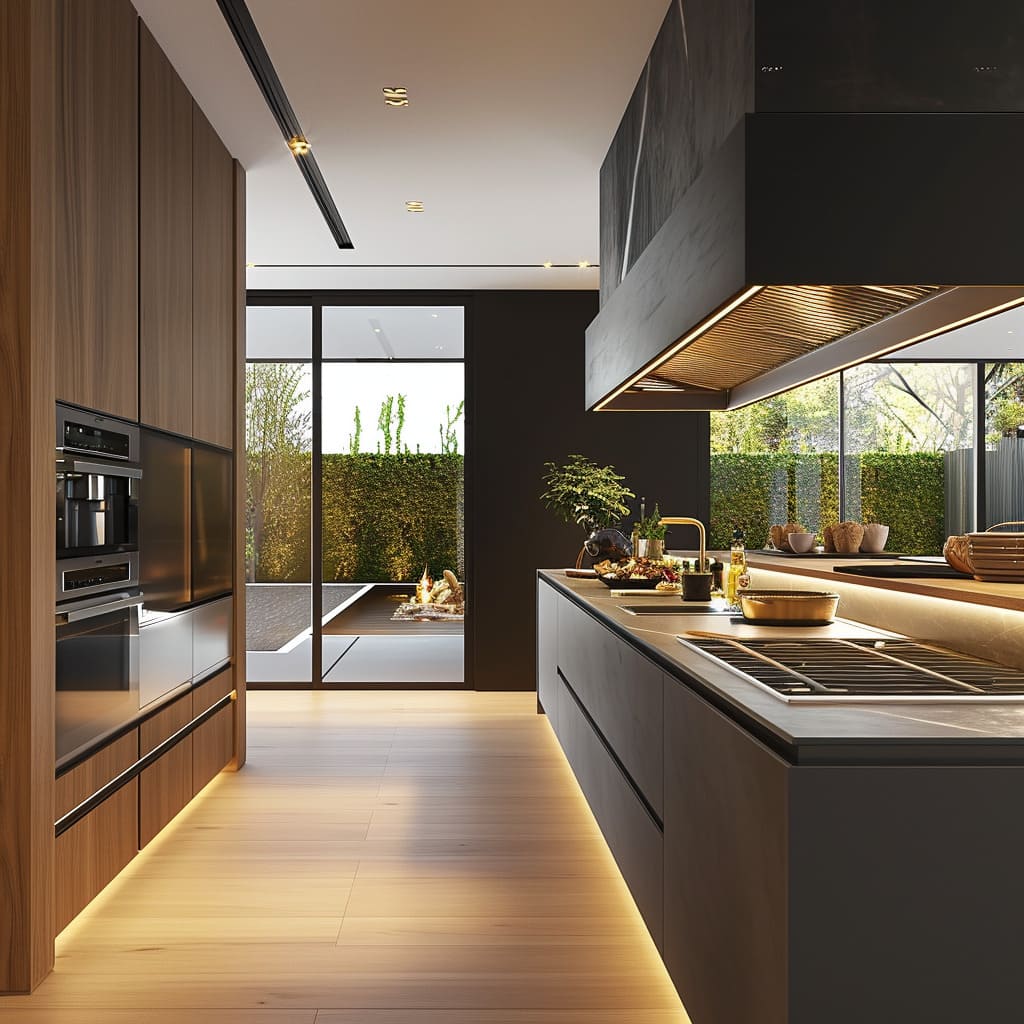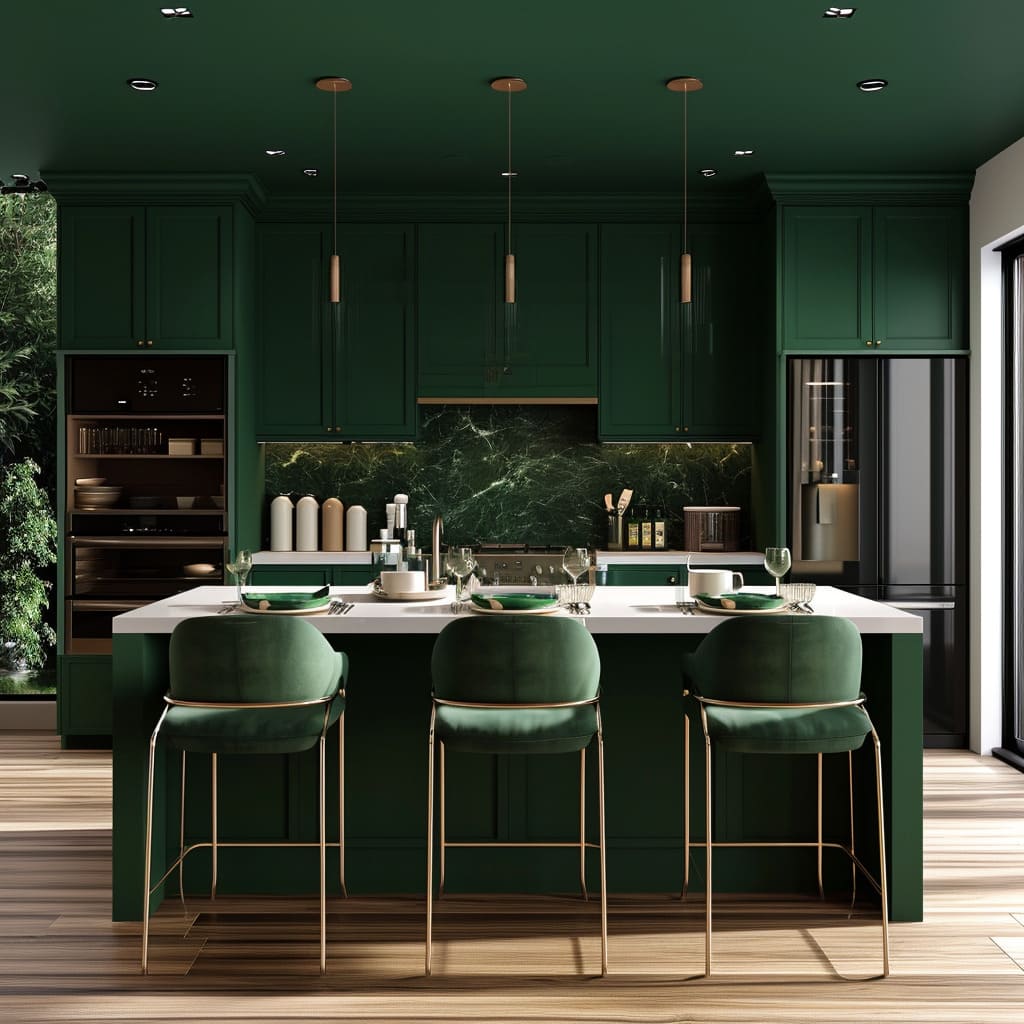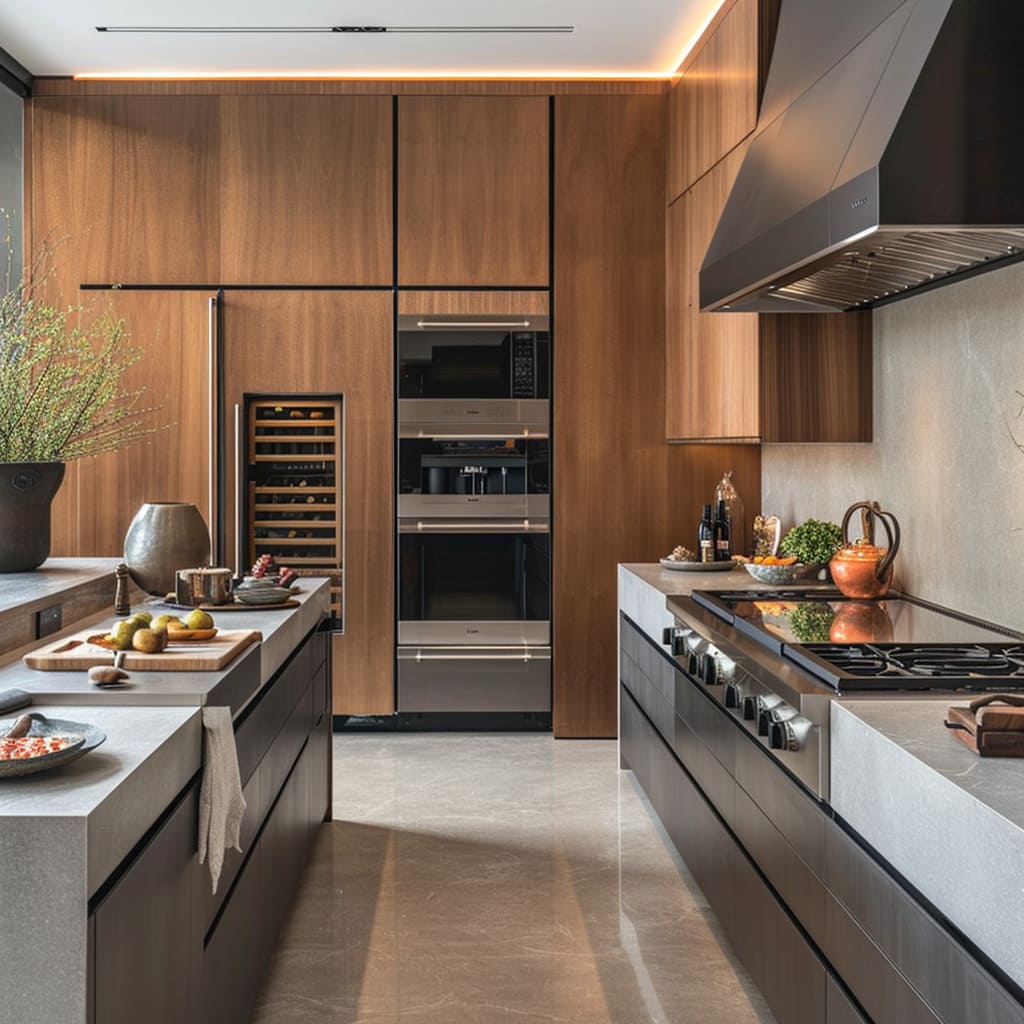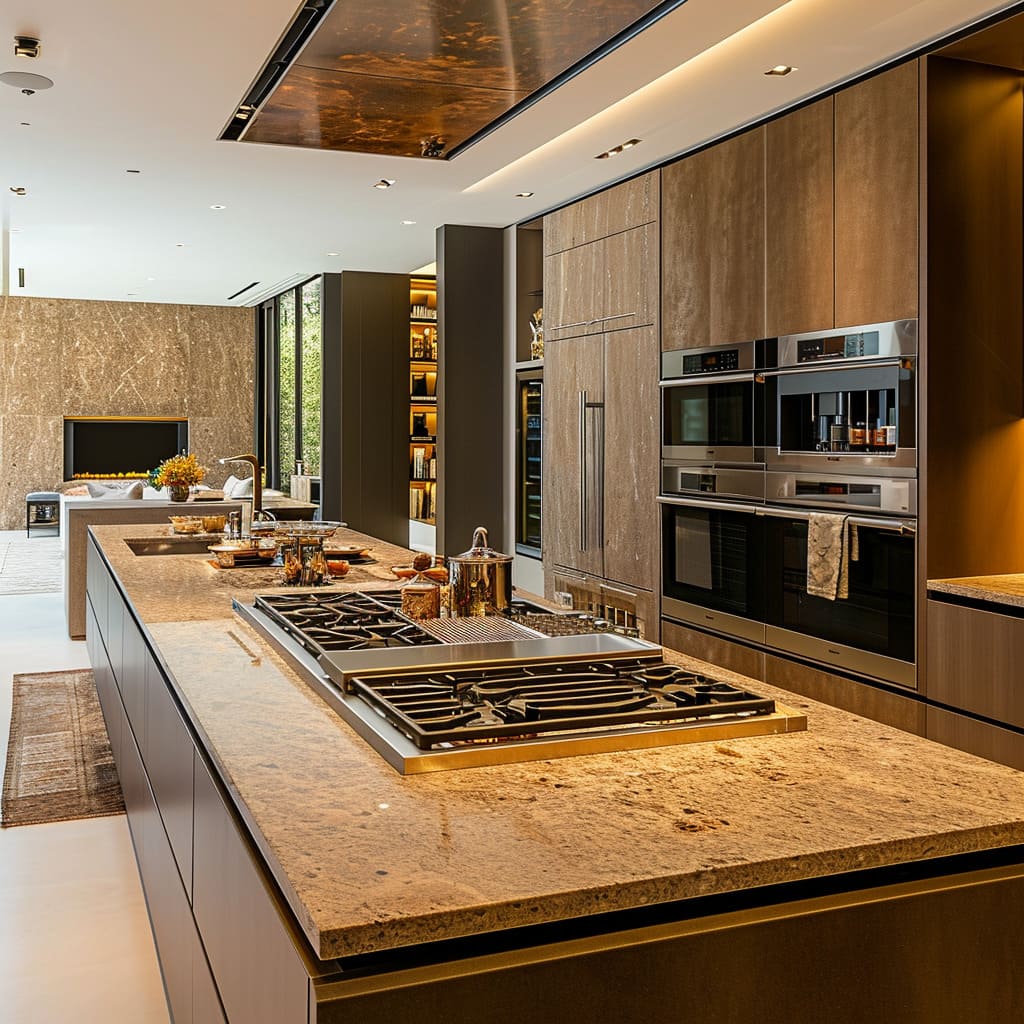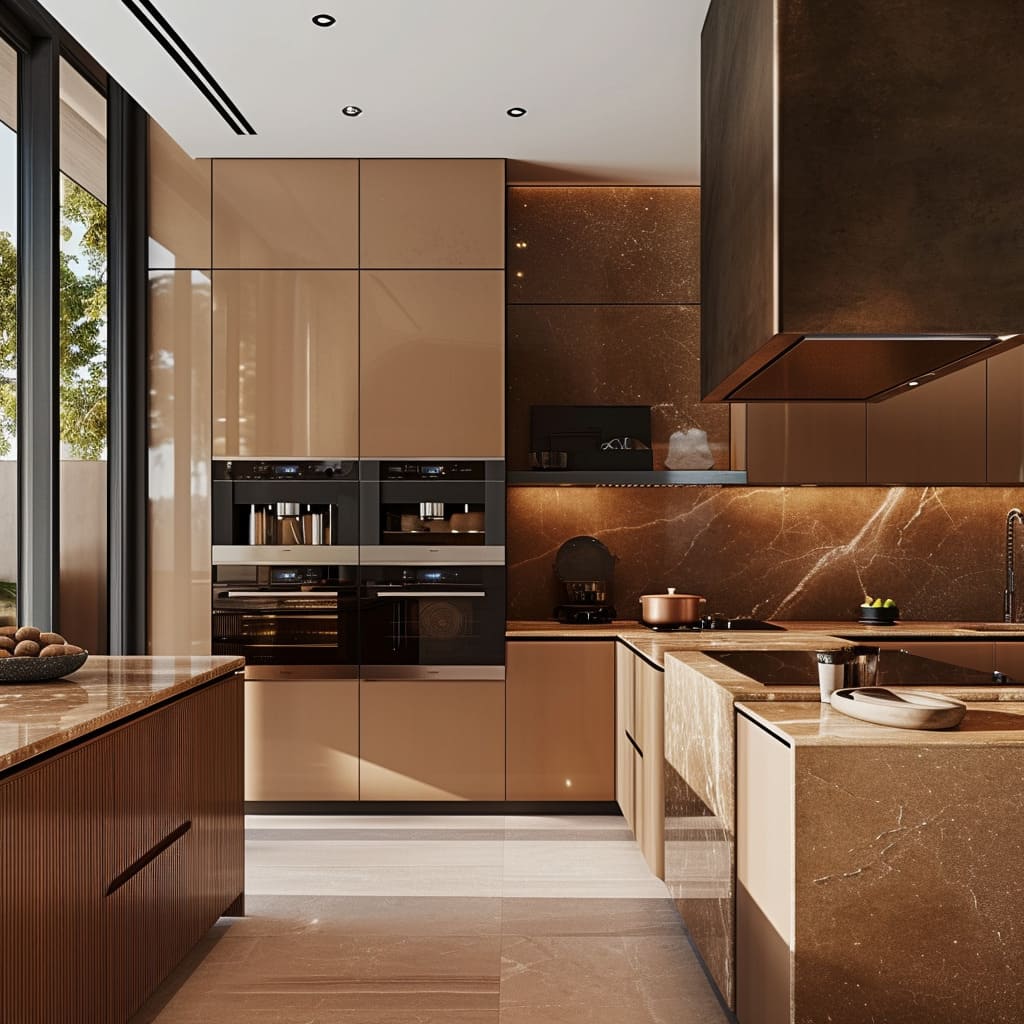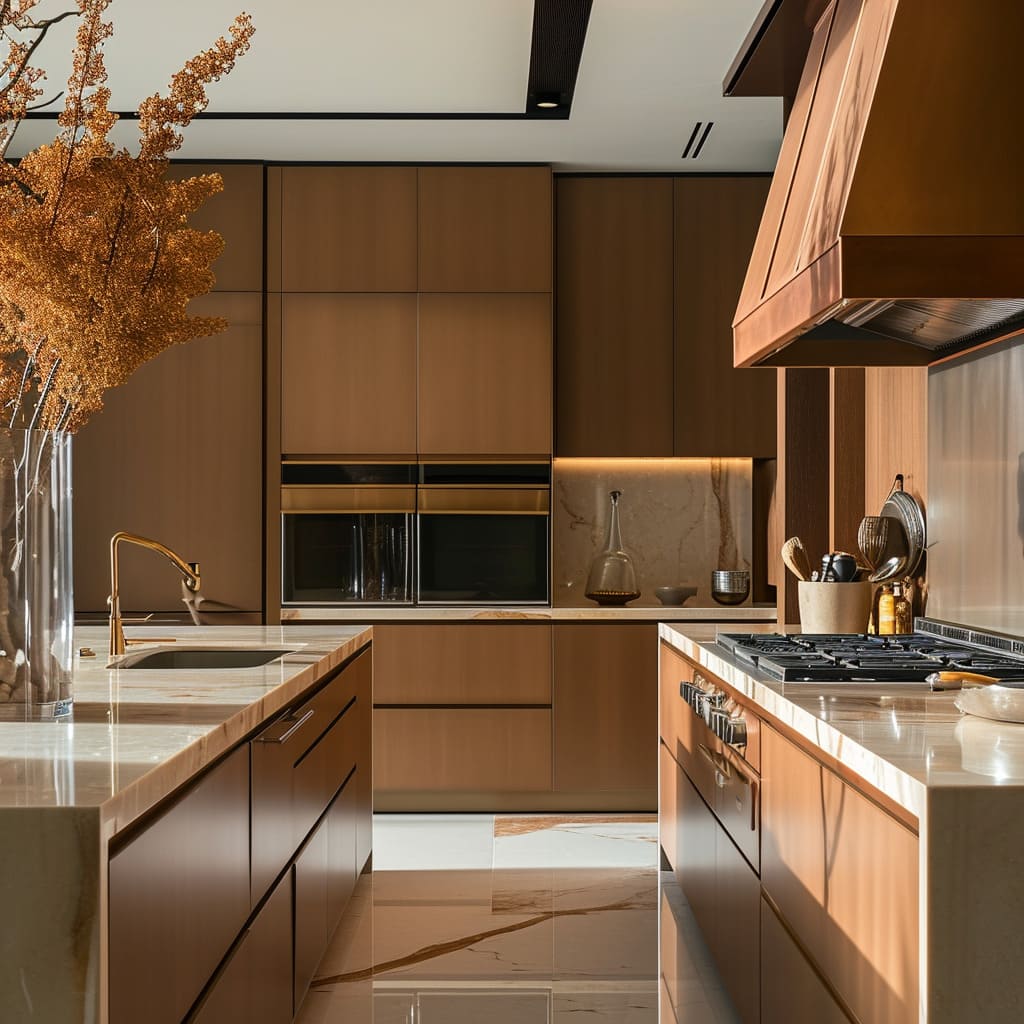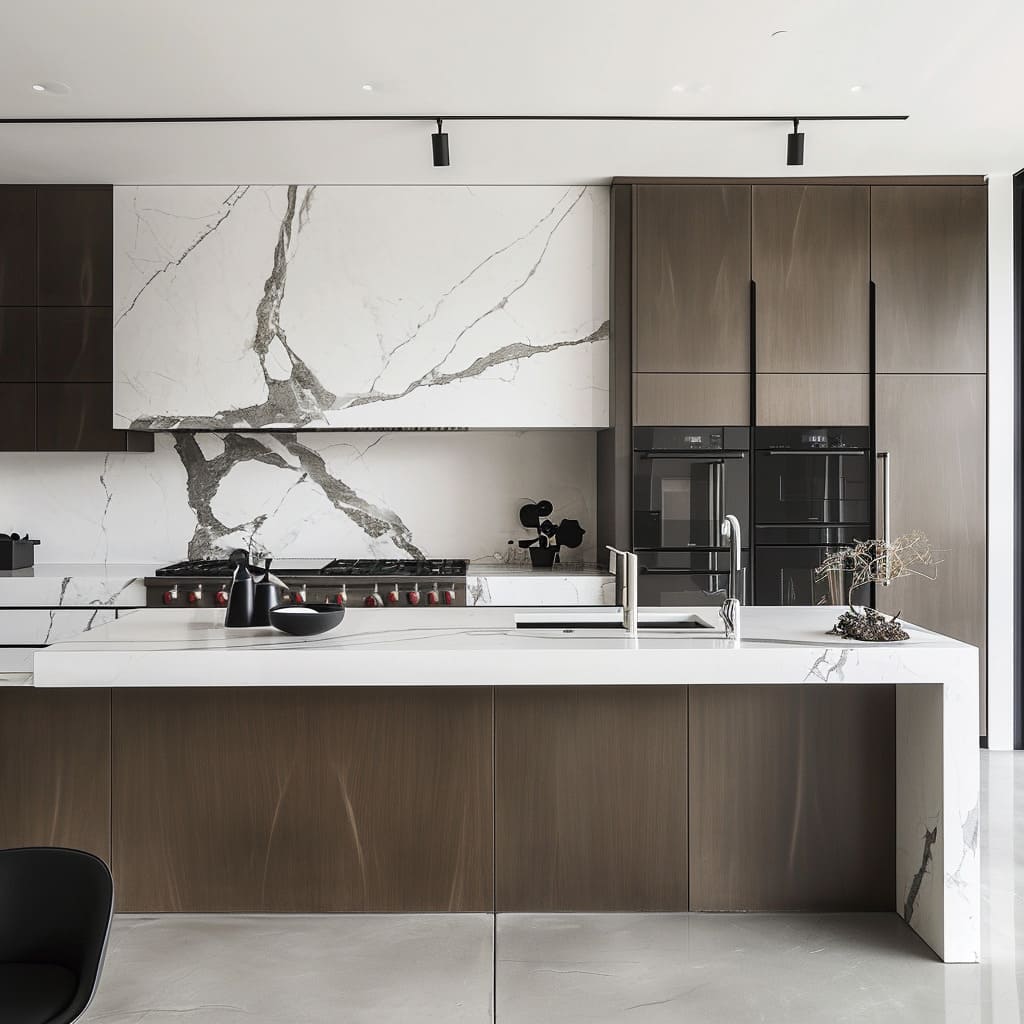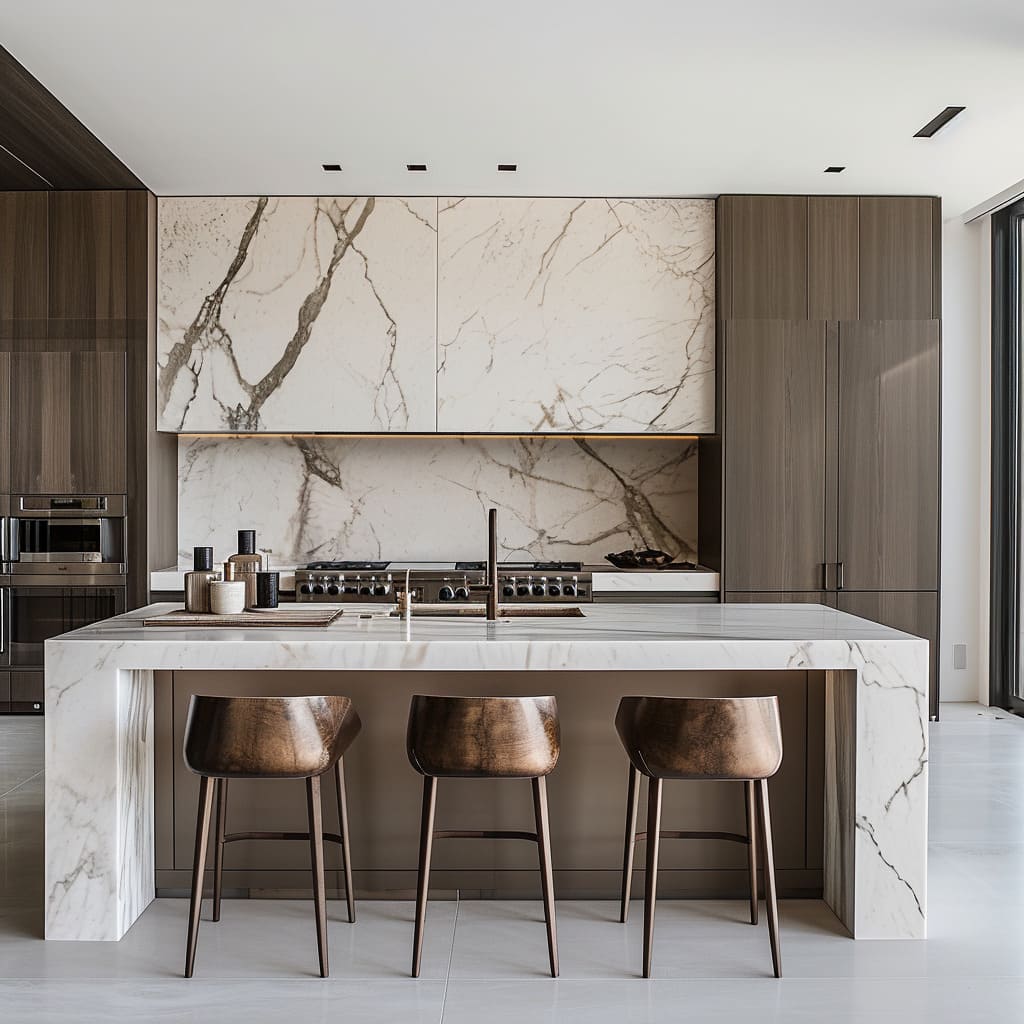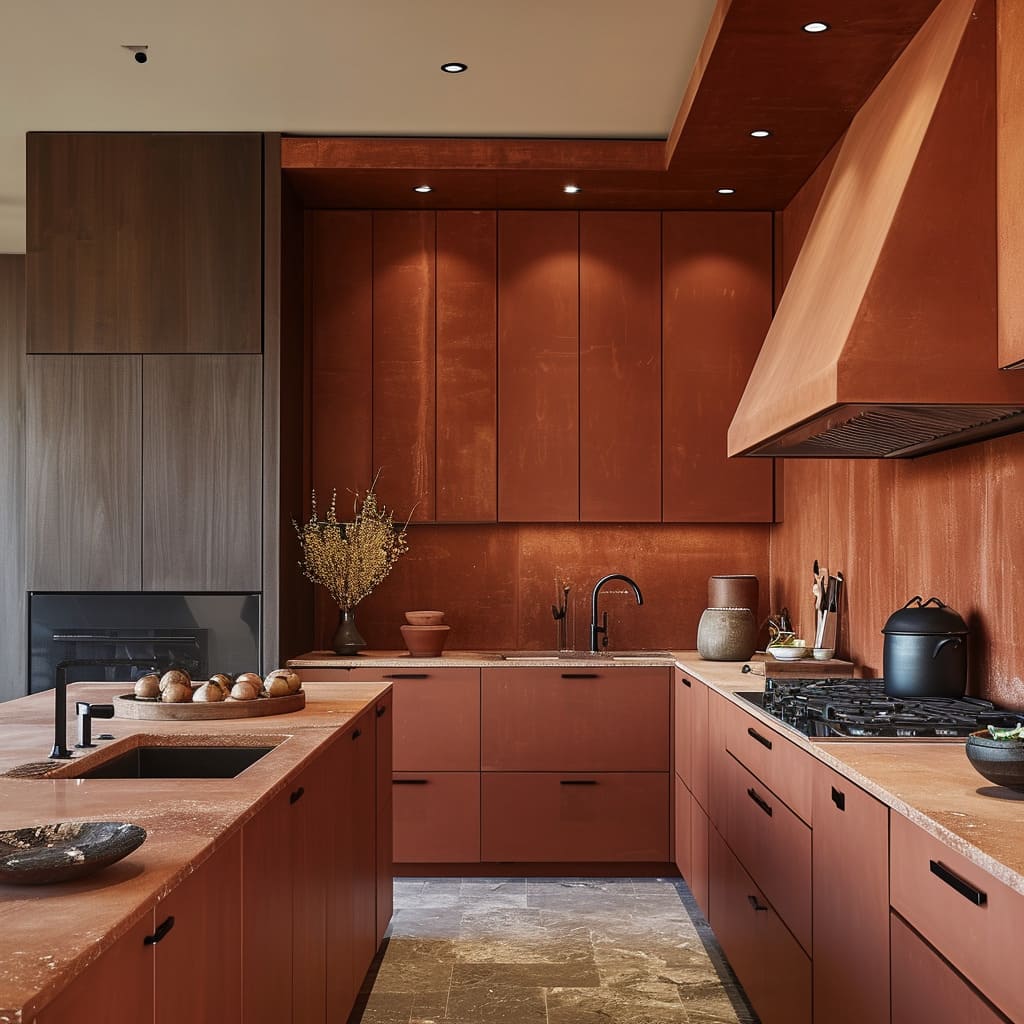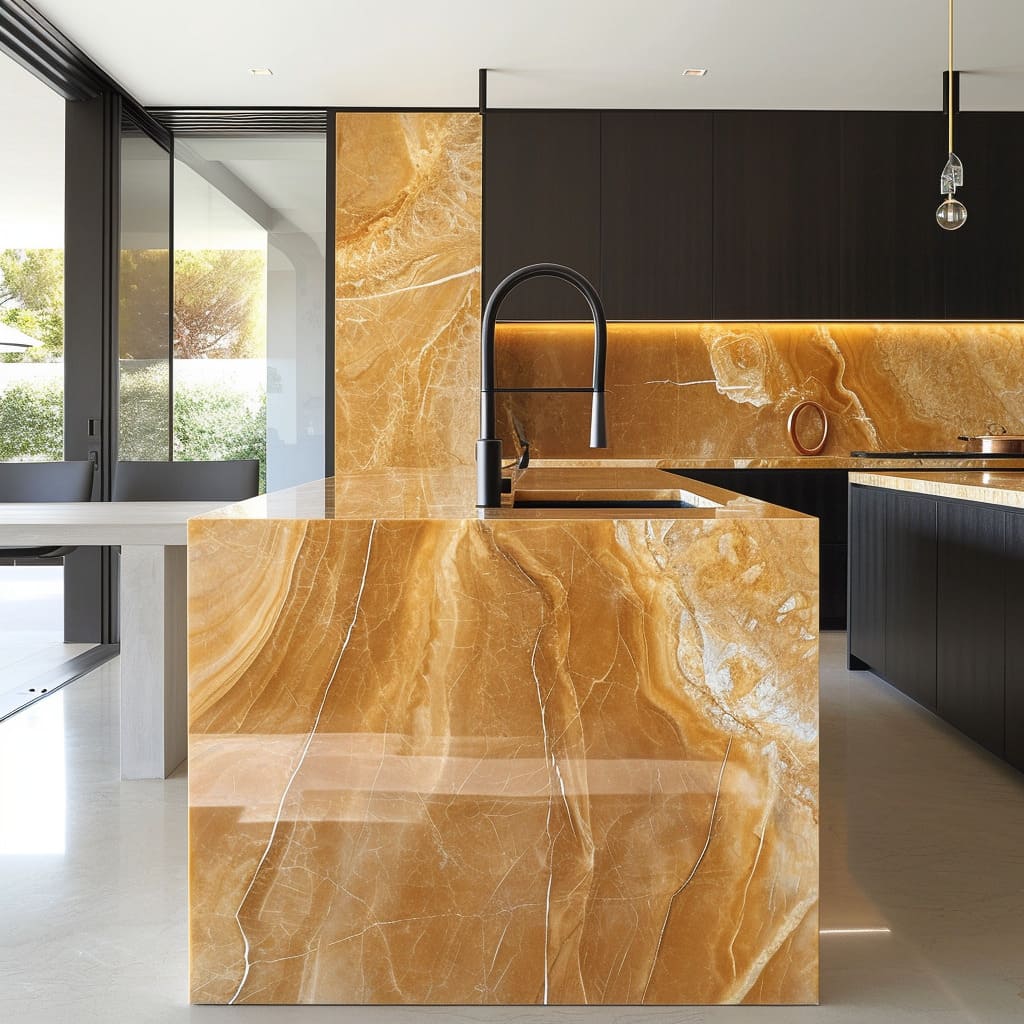The kitchen, once a secluded space designated solely for culinary tasks, has evolved into a central hub of home life, a testament to design innovation where form meets function with seamless sophistication. This exploration delves into the hallmarks of contemporary kitchen design, where each element—from the color palette to the integration of technology—plays a pivotal role in crafting spaces that are not only efficient and functional but also aesthetically compelling and welcoming.
As we navigate through the modern kitchen’s features, we uncover how today’s designs are as much about creating a personal experience as they are about providing practical solutions for the art of cooking and the joy of gathering.
Chromatic Harmony and Accentuation
The kitchens display a neutral color palette with shades of grey, white, and black predominating. These colors contribute to a sleek and timeless appearance.
Some designs introduce bold colors like yellow or purple as accents, which serve as a focal point. The neutral tones are often complemented by subtle textures and finishes that add depth and interest to the space.
Matte, gloss, and satin finishes can be mixed to create a layered look that is visually engaging.
When brighter colors are used, they are typically in controlled doses, such as on a feature wall or as decorative accents like vases or kitchen appliances, which can be easily changed out to update the look. These strategic color choices are not only stylish but also help in defining different zones within the kitchen, especially in open-plan spaces where the kitchen transitions seamlessly into living areas.
Material Selection
There is a significant use of marble, especially for countertops and backsplashes, which adds a touch of luxury and elegance. The veining in the marble is often prominent, serving as a natural decoration.
Additionally, wood is used in cabinetry to introduce warmth and texture.
High-durability materials like quartz and composite surfaces are also popular, providing the look of natural stone while offering enhanced functionality and resistance to stains and scratches. Metal finishes, like brushed nickel or chrome, are used for fixtures and hardware, providing a clean and modern touch that contrasts beautifully with the natural stone and wood.
The juxtaposition of these materials can create a balance between industrial and organic, which is at the heart of contemporary design.
Cabinetry Design and Ergonomics
The cabinetry is characterized by flat-panel doors, with handleless designs in some cases, which reinforces the minimalist theme. The cabinets often extend to the ceiling, maximizing storage space and creating a clean line at the top of the room.
Beyond aesthetics, the cabinetry is designed with ergonomics in mind. Systems like soft-close drawers and pull-out organizers improve the usability and comfort of the kitchen.
In some designs, upper cabinets are replaced with open shelving, which lightens the visual weight of the space and offers an opportunity to display decorative items or everyday dishes in an organized manner. The materials used for cabinetry often include eco-friendly options like bamboo or reclaimed wood, aligning modern design with environmental consciousness.
Illumination Techniques and Ambience Creation
Integrated lighting solutions are common, such as LED strips under cabinets or along the ceiling, which not only provide task lighting but also contribute to the ambiance. Pendant lights over islands or dining areas become statement pieces that can add a touch of personality.
Task lighting is critical in a kitchen, and modern designs often incorporate adjustable and directional lighting fixtures to ensure that work surfaces are well lit. Ambient lighting is achieved through dimmable ceiling lights, which can change the mood of the space.
The latest designs may include smart lighting systems that can be controlled via smartphone or voice commands, allowing for real-time adjustments based on the time of day or activity taking place.
Appliance Integration and Efficiency
High-end, stainless steel appliances are standard, including built-in ovens and coffee machines, which are integrated into the cabinetry for a seamless look. Gas cooktops or induction ranges are prominent, often with a modern extractor hood or a built-in downdraft system.
Energy efficiency is a hallmark of modern kitchen appliances. Refrigerators, dishwashers, and cooking appliances often boast high energy ratings, reducing the carbon footprint of the home.
Many appliances are now designed to be fully integrated, flush with cabinetry, or even hidden behind cabinet panels to maintain the sleek lines of the design. Smart appliances that connect to the internet are also becoming standard, providing convenience like remote diagnostics and the ability to start preheating an oven from your phone.
Spatial Dynamics and Functional Flow
The layouts are open and functional, with kitchen islands serving as the centerpiece. The islands often have a waterfall countertop, where the material flows down the sides, creating a continuous form.
They serve multiple purposes, from preparation space to dining area.
The flow of the space is carefully considered to optimize movement between the refrigerator, sink, and cooktop, which are the key working points of any kitchen. This work triangle is designed to minimize unnecessary steps and create a more efficient cooking environment.
Some modern kitchen designs also include a butler’s pantry or a secondary prep area, keeping the main kitchen space uncluttered and focused on social interaction and entertainment.
Flooring Foundations and Comfort Features
The flooring tends to be simple yet elegant, with large tiles or hardwood floors. This choice complements the overall minimalist design and can help to visually expand the space.
In high-traffic areas like the kitchen, the flooring must be not only stylish but also durable and easy to clean. Many modern kitchens opt for luxury vinyl or laminate flooring that mimics the look of wood or stone but provides greater resistance to moisture and wear.
Underfloor heating systems are also a luxury feature that is increasingly common, adding comfort underfoot in cooler climates.
Backsplash as a Design Statement
In many designs, the backsplash is either made of the same material as the countertop for continuity or is a glass or high-gloss material that reflects light and adds depth to the space.
The backsplash often extends from the countertop to the underside of the upper cabinets, creating a continuous surface that is easy to clean and maintain. In some designs, the backsplash becomes a work of art, with custom tiles, intricate patterns, or unique materials like tempered glass or reflective metal adding a distinctive touch to the kitchen.
Furniture Selection and Adaptability
The choice of furniture, like bar stools or chairs, often reflects the color scheme and materials of the kitchen, such as metallic frames or leather upholstery, to maintain a cohesive design.
Ergonomics play a significant role in furniture selection, with adjustable height bar stools or chairs with lumbar support ensuring comfort during longer periods of sitting. The furniture often includes hidden functionalities, such as storage compartments or stackable designs that save space when not in use.
Maximizing Light and Exterior Connectivity
Large windows or sliding doors are a recurring feature, connecting the kitchen to the outdoors and flooding the space with natural light.
Large windows that blend indoor kitchens with the outdoor environment are just one of the innovative features thanks to modern architecture. Explore our article to see how these designs enhance our living spaces.
The strategic placement of windows not only maximizes natural light but also takes advantage of any available views, creating a visual connection with the outdoor environment. Skylights or solar tubes are additional options to bring more natural light into the space, especially in kitchens that are situated in the center of the home or have limited wall space for windows.
Decorative Essentials and Minimalist Styling
Kitchens are accessorized minimally, with a focus on functionality. Decorative elements, when present, are carefully curated to complement the modern aesthetic, such as vases, bowls, or small planters.
Functional items like magnetic knife strips, hanging pot racks, or built-in soap dispensers are designed to blend seamlessly with the kitchen’s aesthetic while adding to its utility. Plants, whether real or artificial, are also a common sight, introducing a pop of color and a sense of freshness to the space.
Smart Kitchen Innovations and Connectivity
Many kitchens incorporate smart technology, such as automated lighting systems, advanced cooking appliances, and integrated sound systems.
Voice-activated assistants can help with tasks like setting timers or creating shopping lists, while integrated screens on refrigerators or smart displays can provide access to recipes, play music, or even display art. The integration of technology is done in a way that does not interrupt the clean lines of the design but enhances the experience of using the kitchen.
In conclusion, the modern kitchen transcends its traditional role as a place for meal preparation, emerging as a pinnacle of design that harmonizes aesthetics, functionality, and technology. Neutral color palettes are enhanced with strategic splashes of color, creating a timeless yet dynamic visual appeal.
The choice of materials like marble and wood not only infuses luxury but also introduces tactile warmth, making the space inviting. Cabinetry, designed with minimalist elegance, conceals complex ergonomic solutions that facilitate comfort and efficiency.
Lighting, both practical and ambient, transforms the kitchen into a living canvas that adapts to the rhythm of daily life.
State-of-the-art appliances and smart systems blend into the architecture of the kitchen, offering high performance while maintaining the sleek lines of modern design. The thoughtful layout serves as the stage for both culinary creativity and social interaction, with multipurpose islands and an optimized work triangle.
Flooring and backsplashes combine practicality with artistic expression, while expansive windows invite the outside in, enriching the kitchen with natural light. Furniture and decor follow the principle of ‘less is more,’ emphasizing quality and functionality without sacrificing style.
Lastly, integrated technology enhances the cooking experience, making the modern kitchen not just a room, but a hub of innovation, comfort, and style—a true heart of the modern home.

